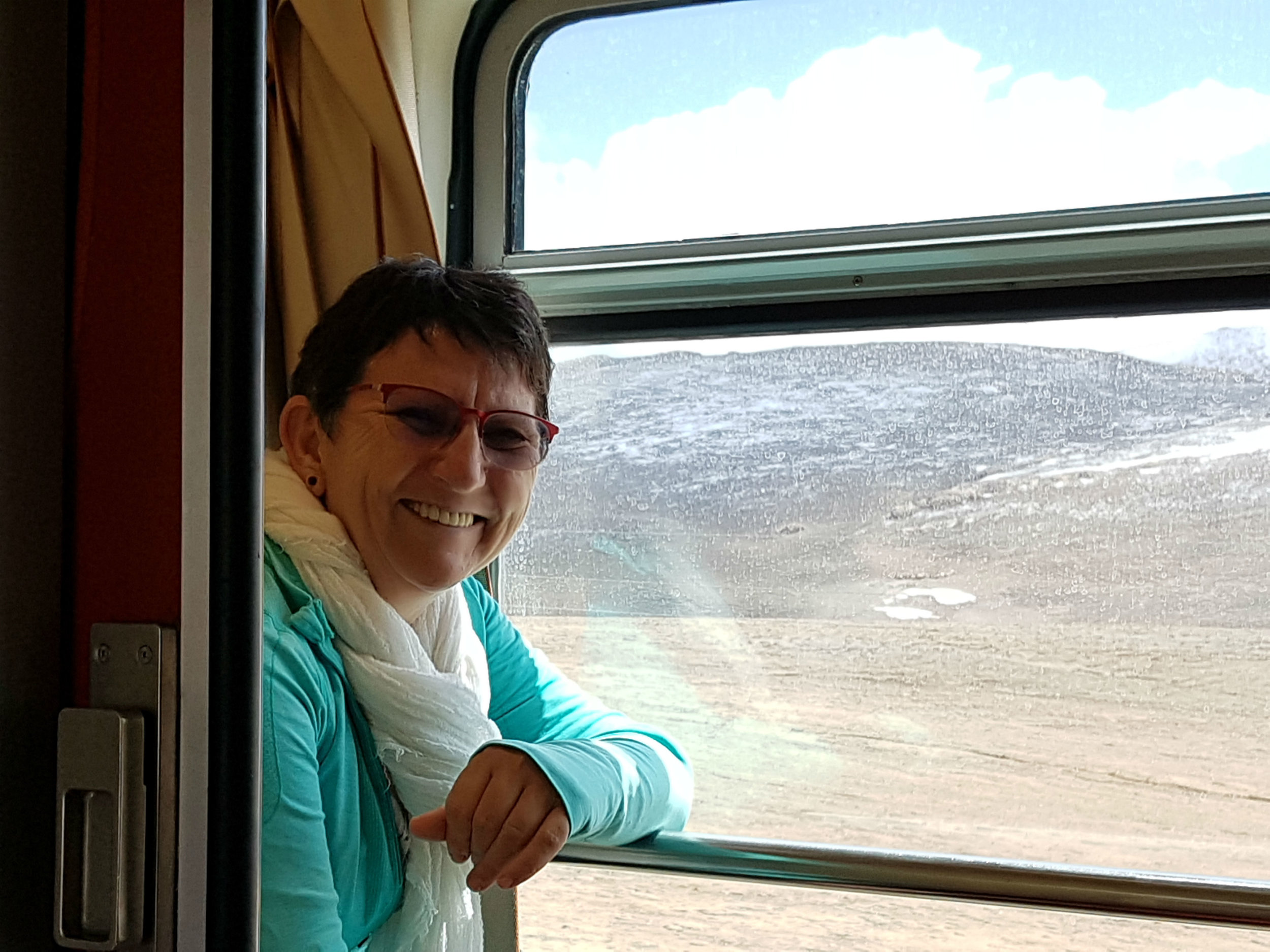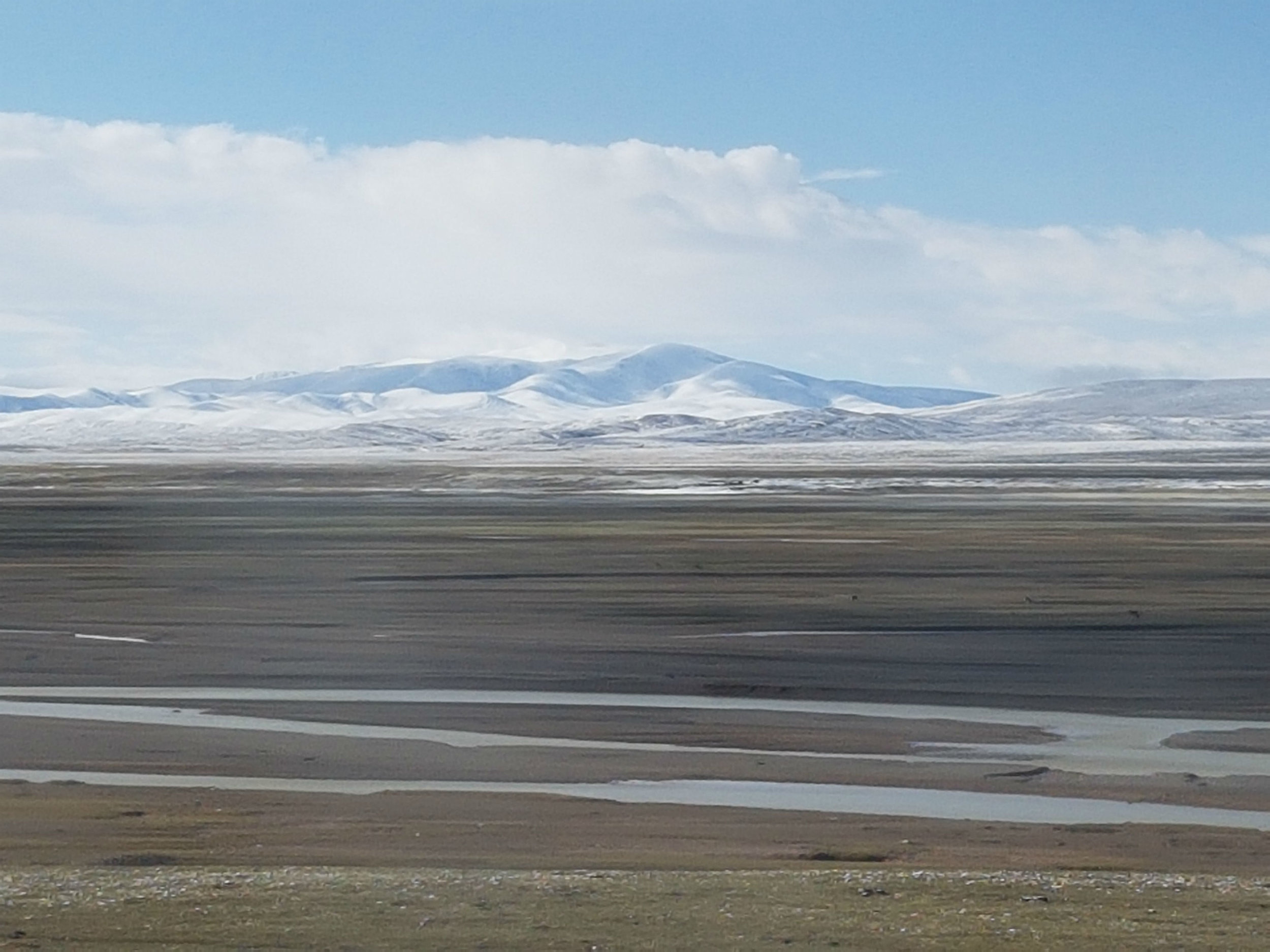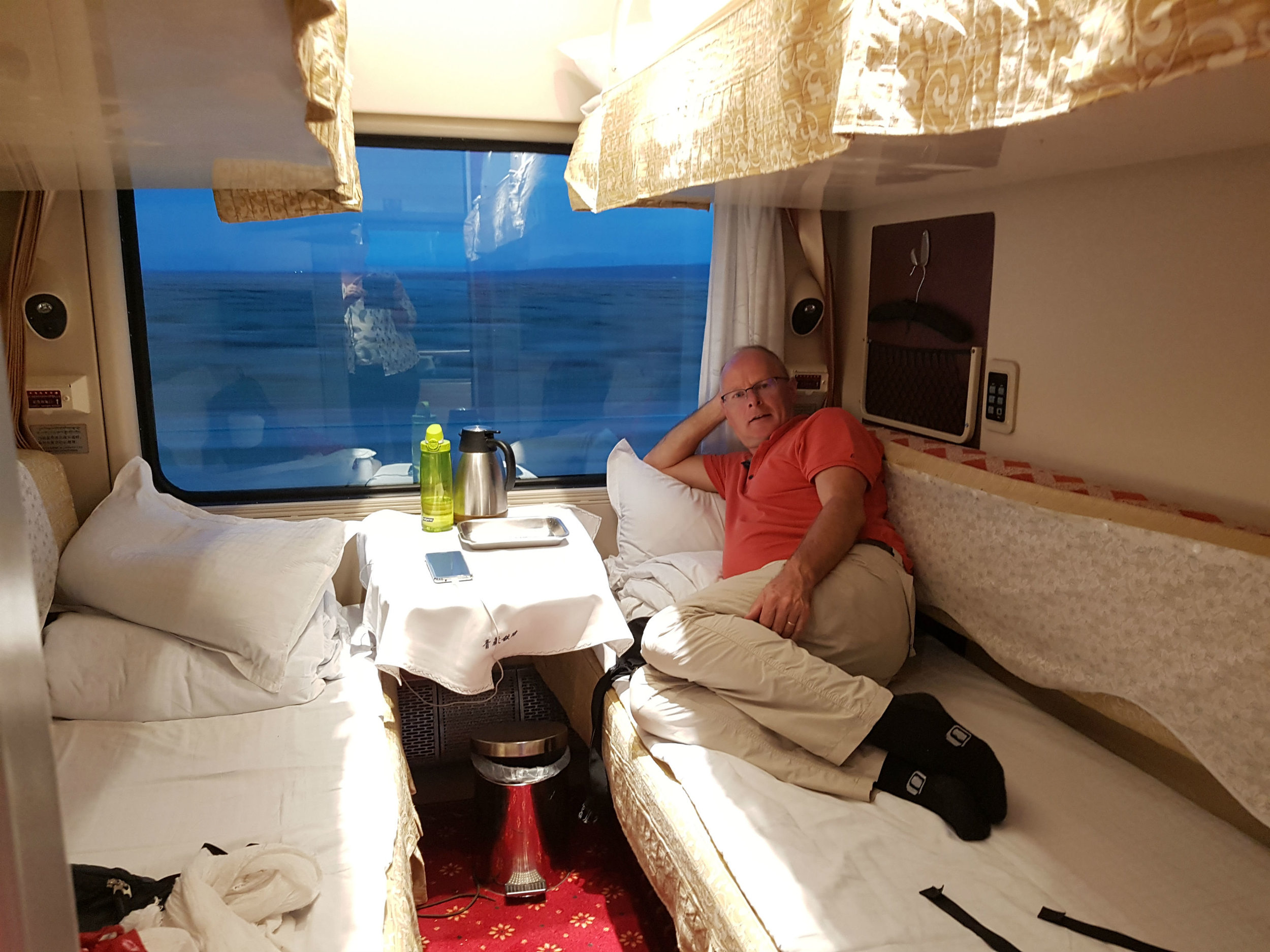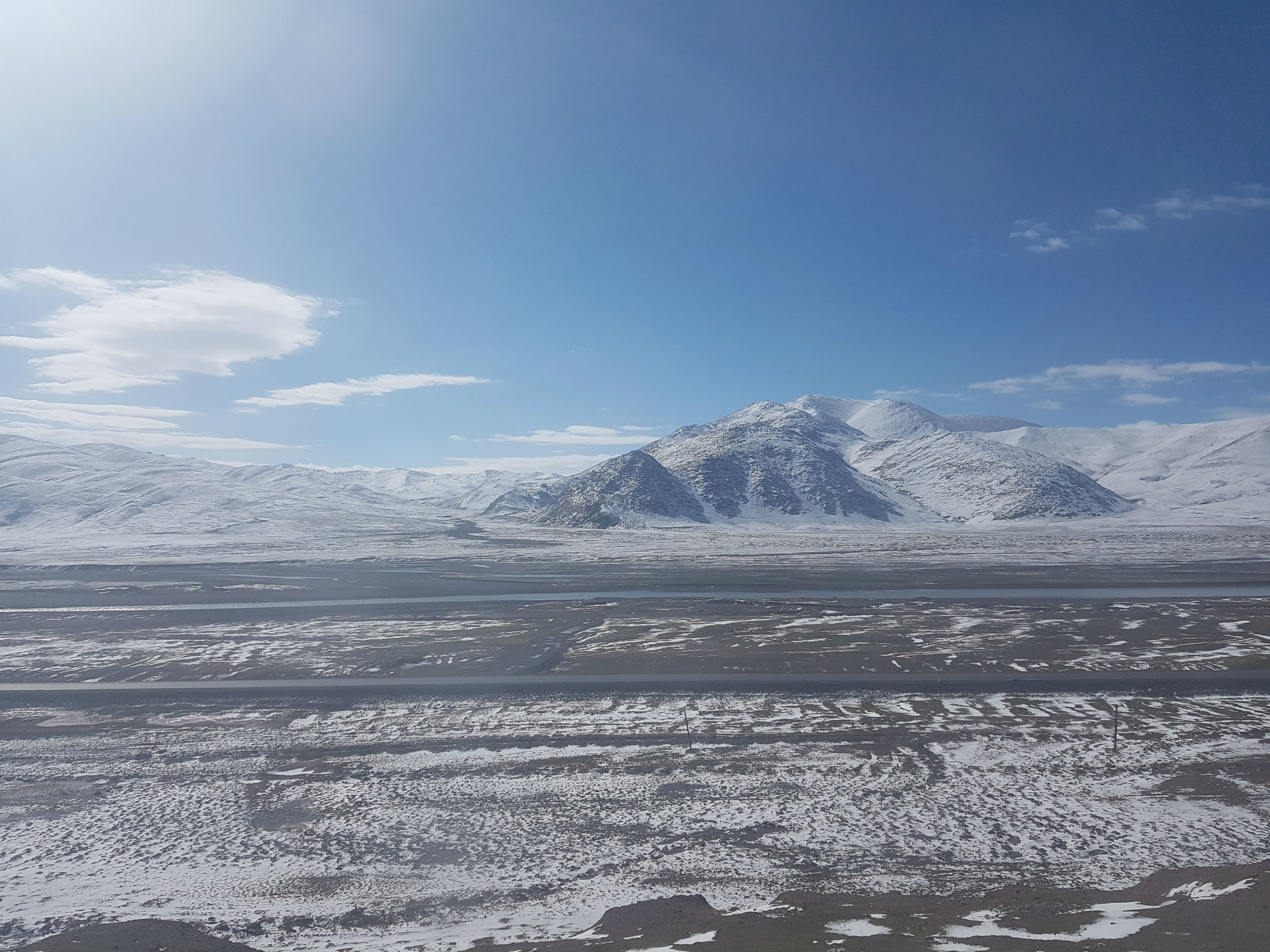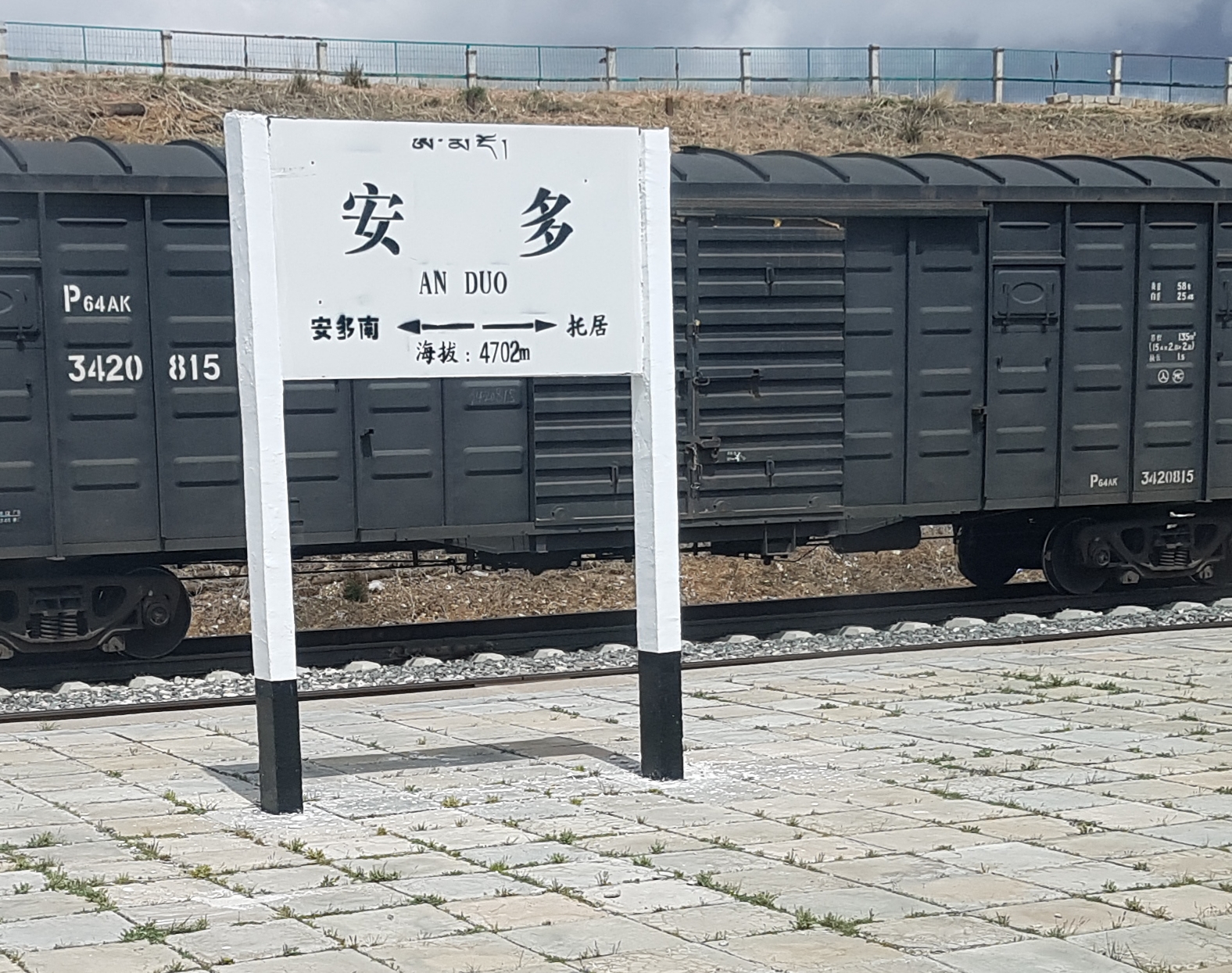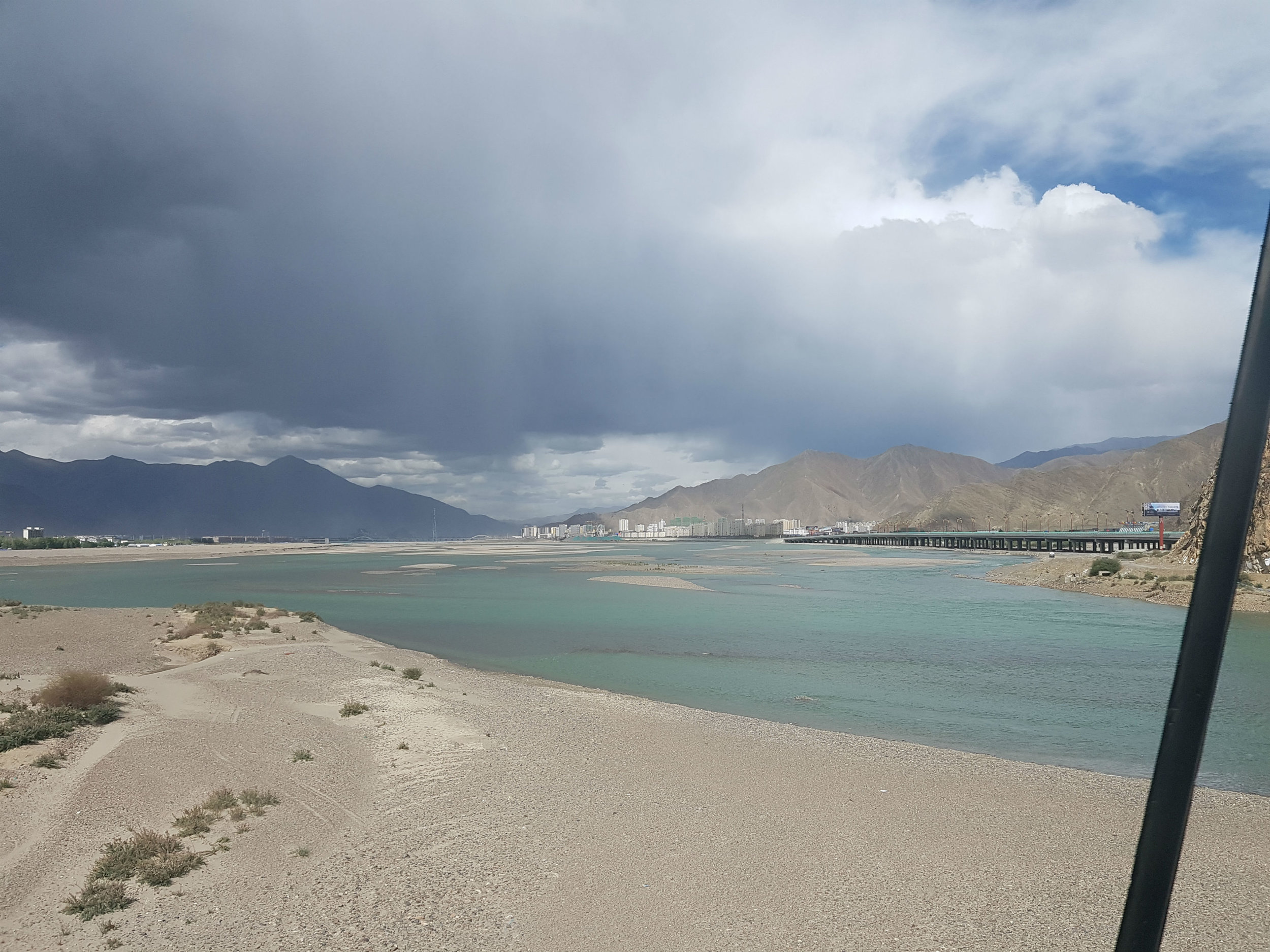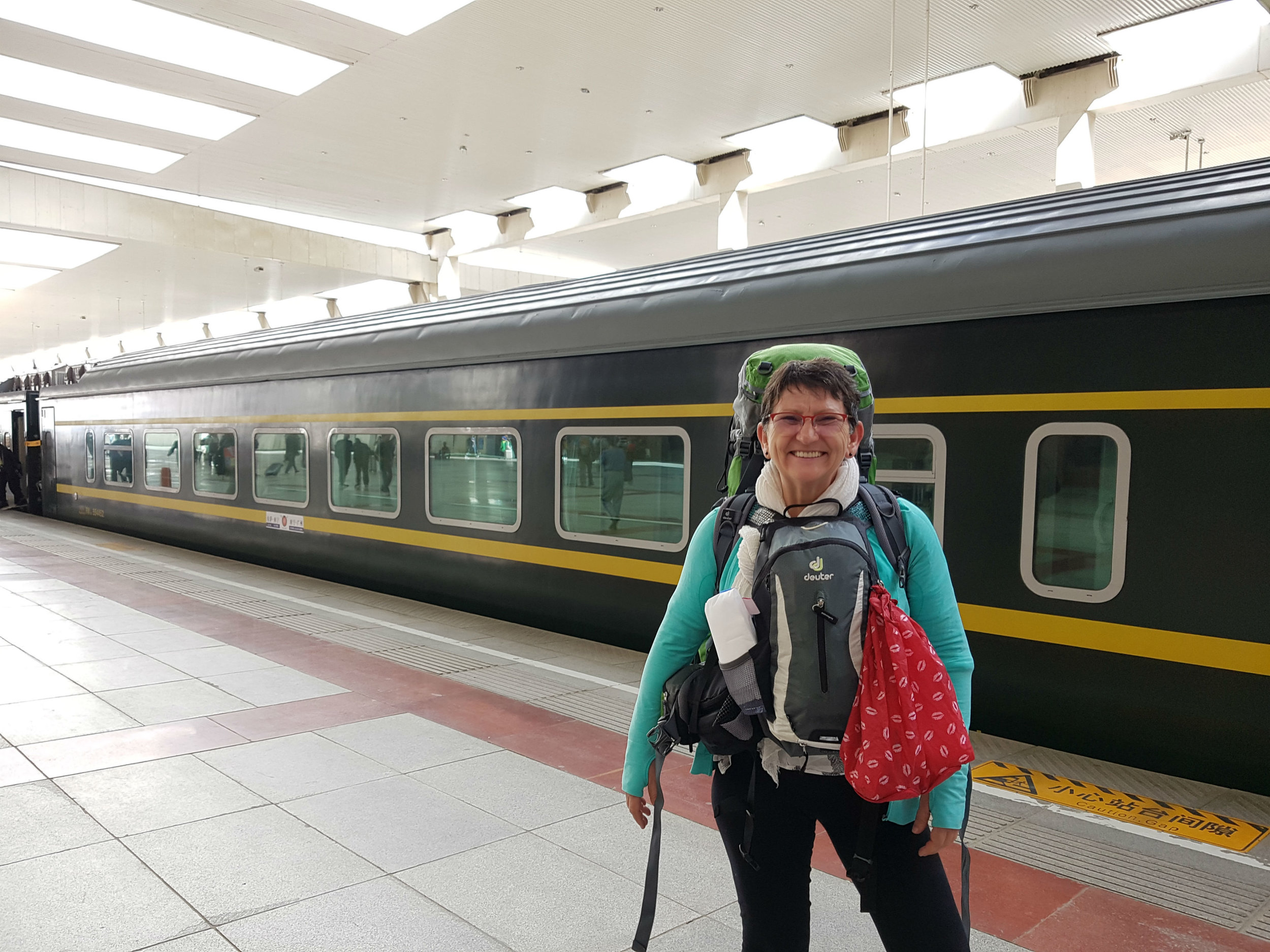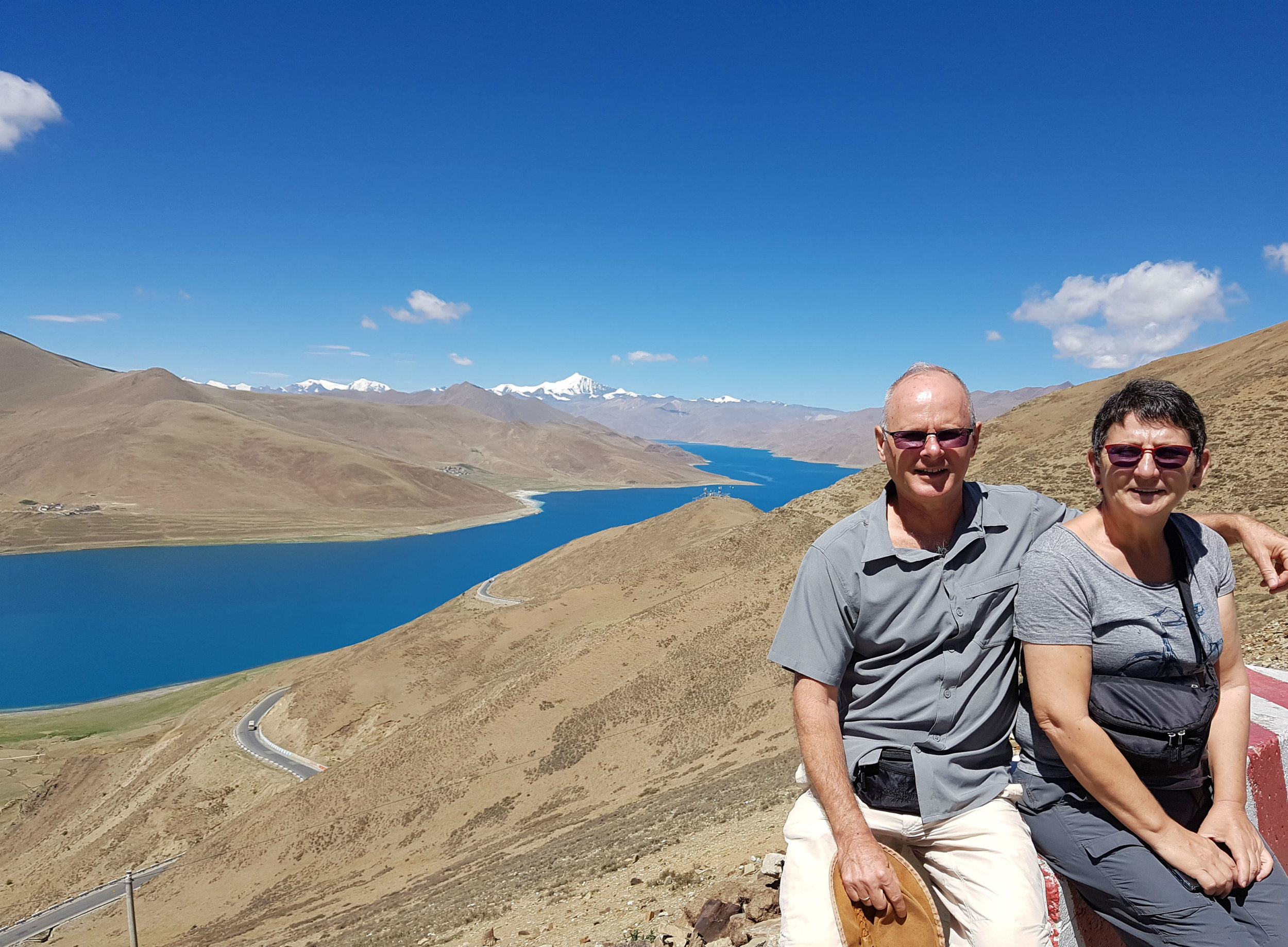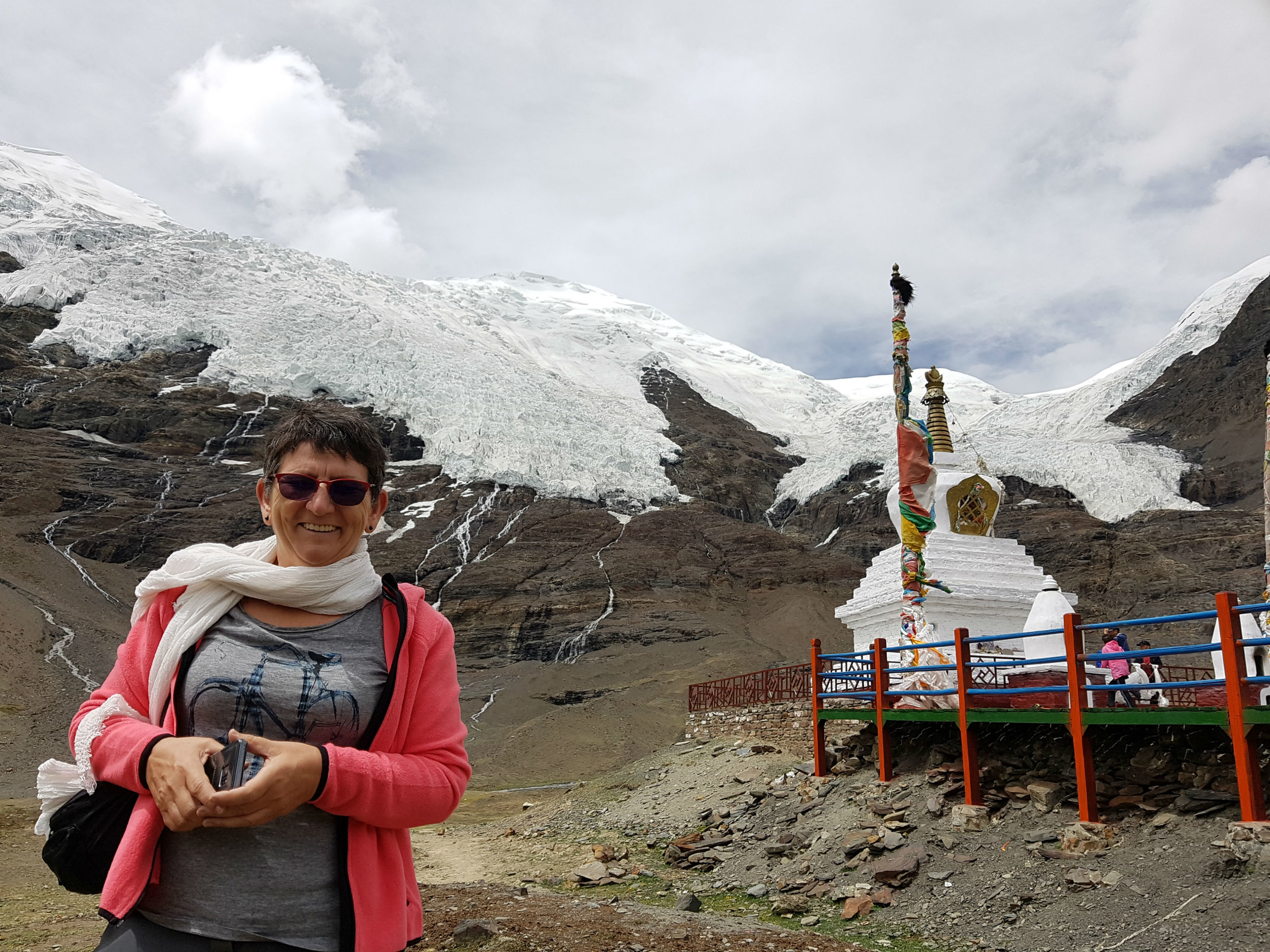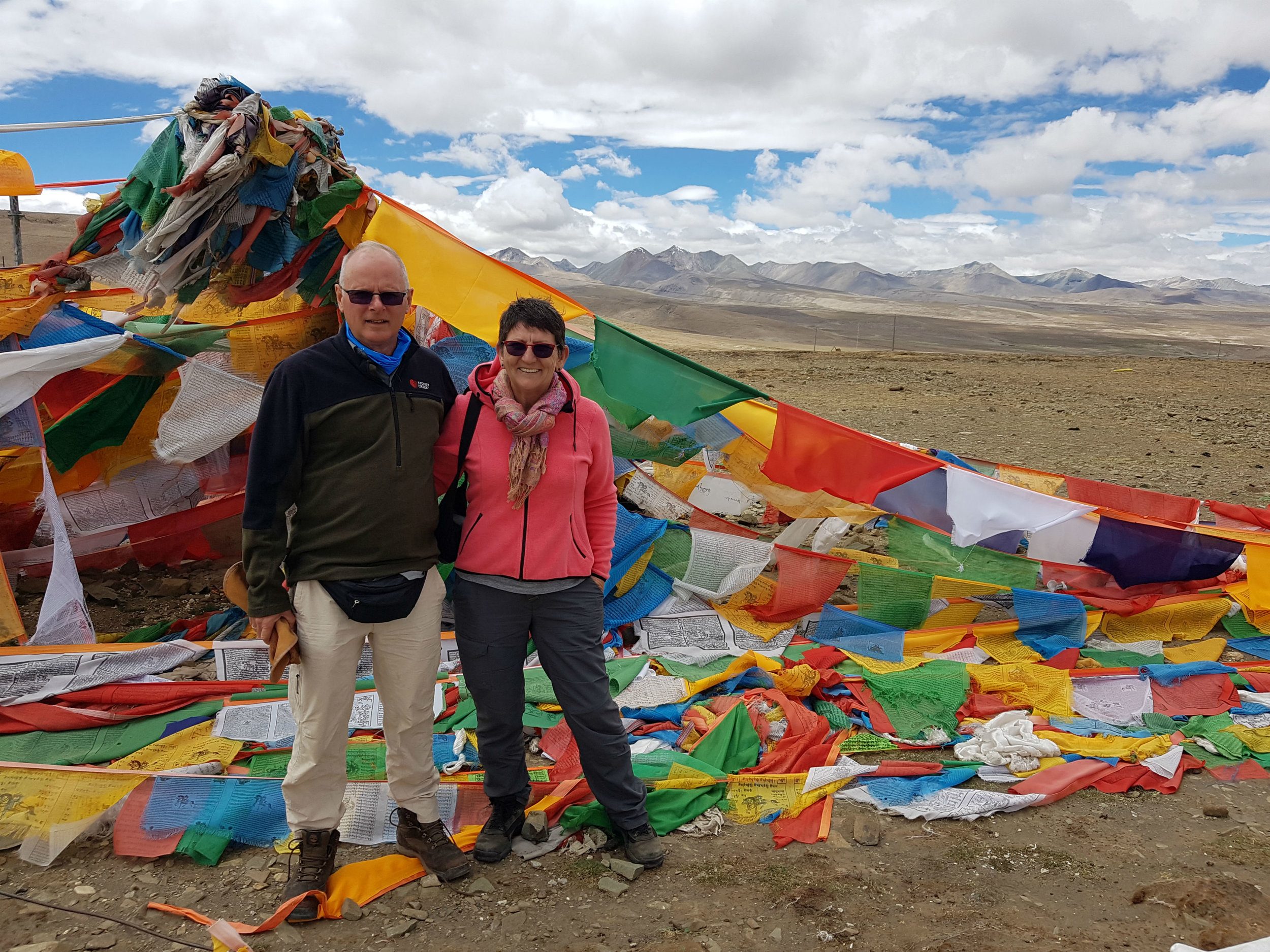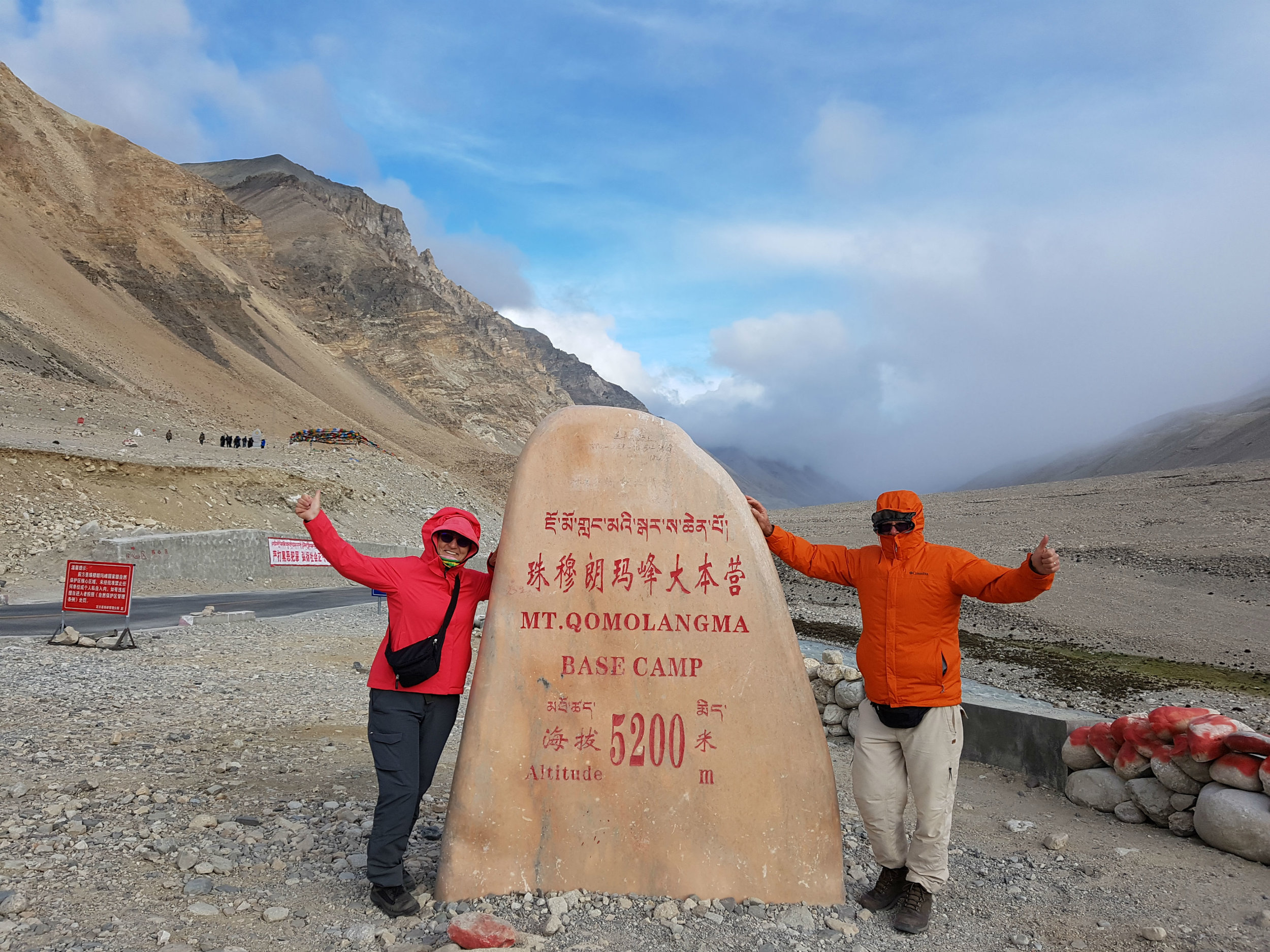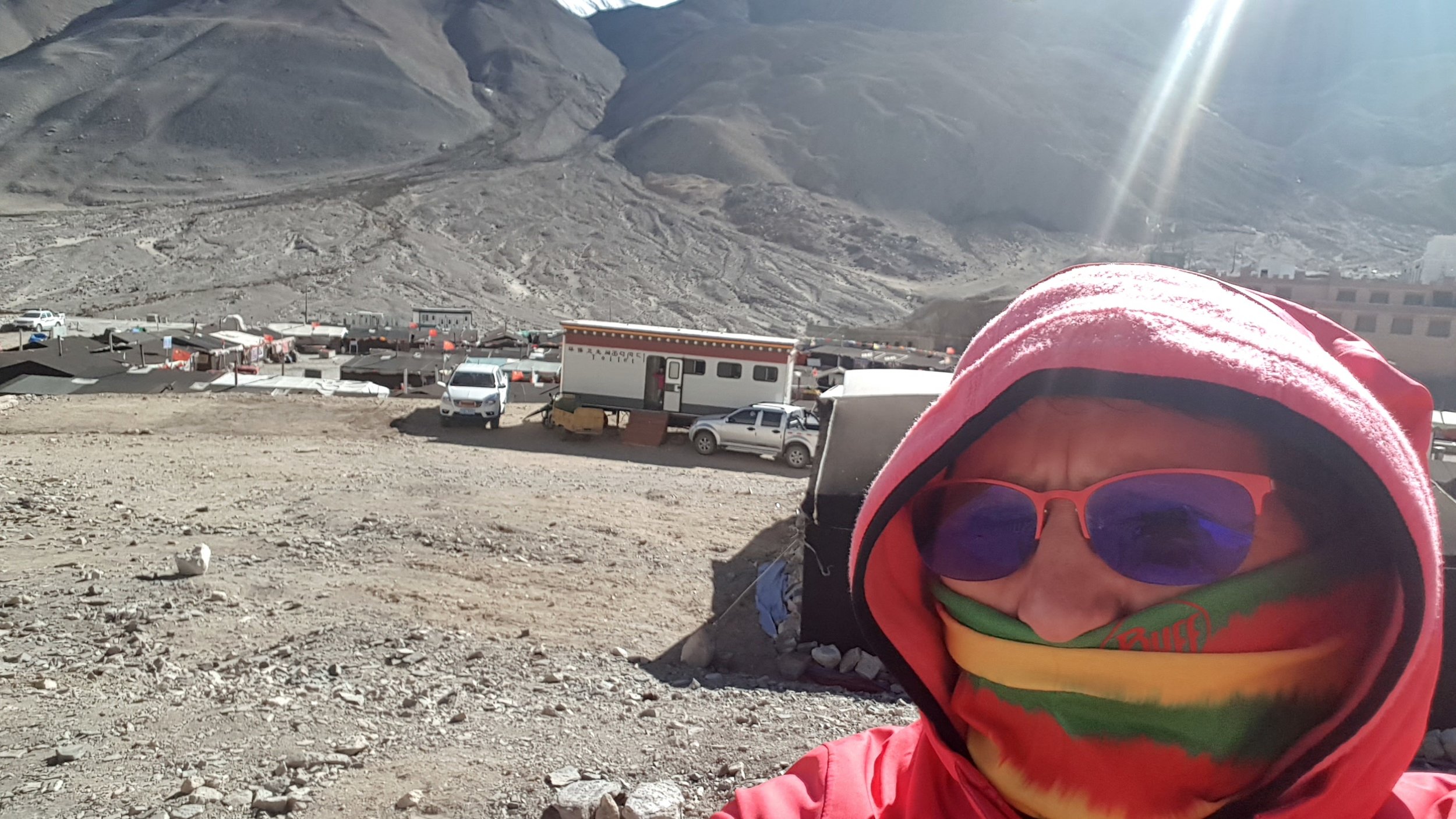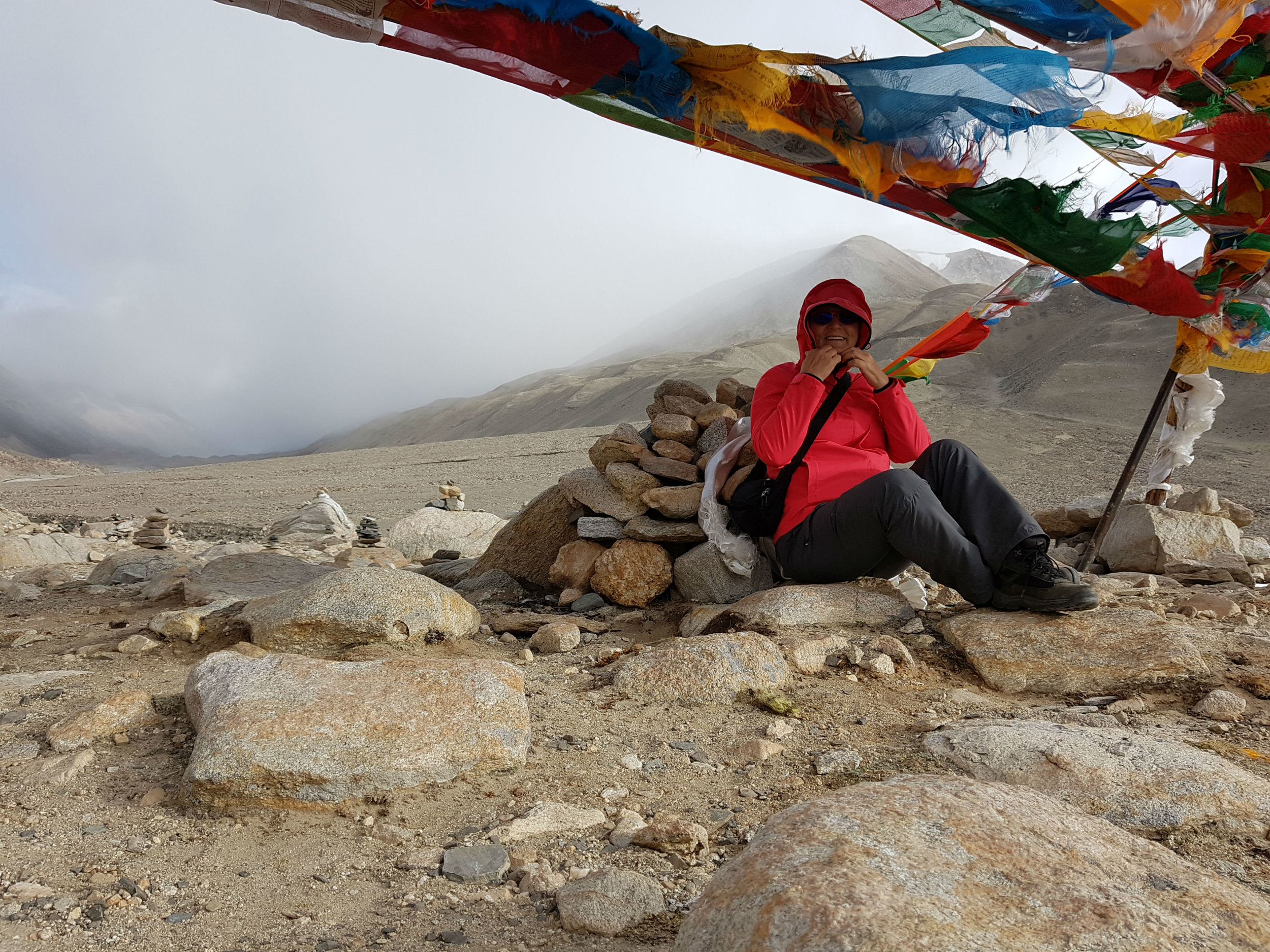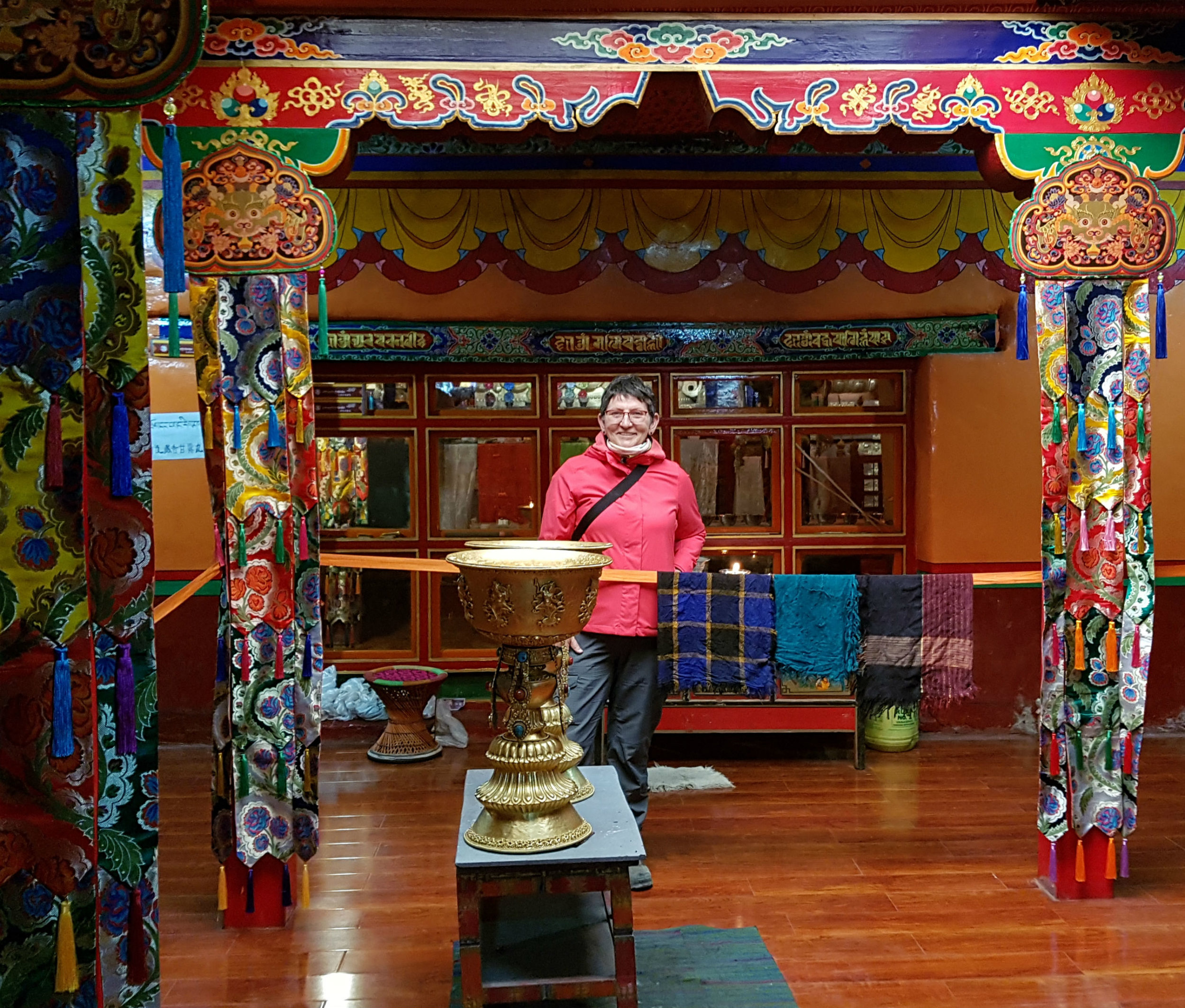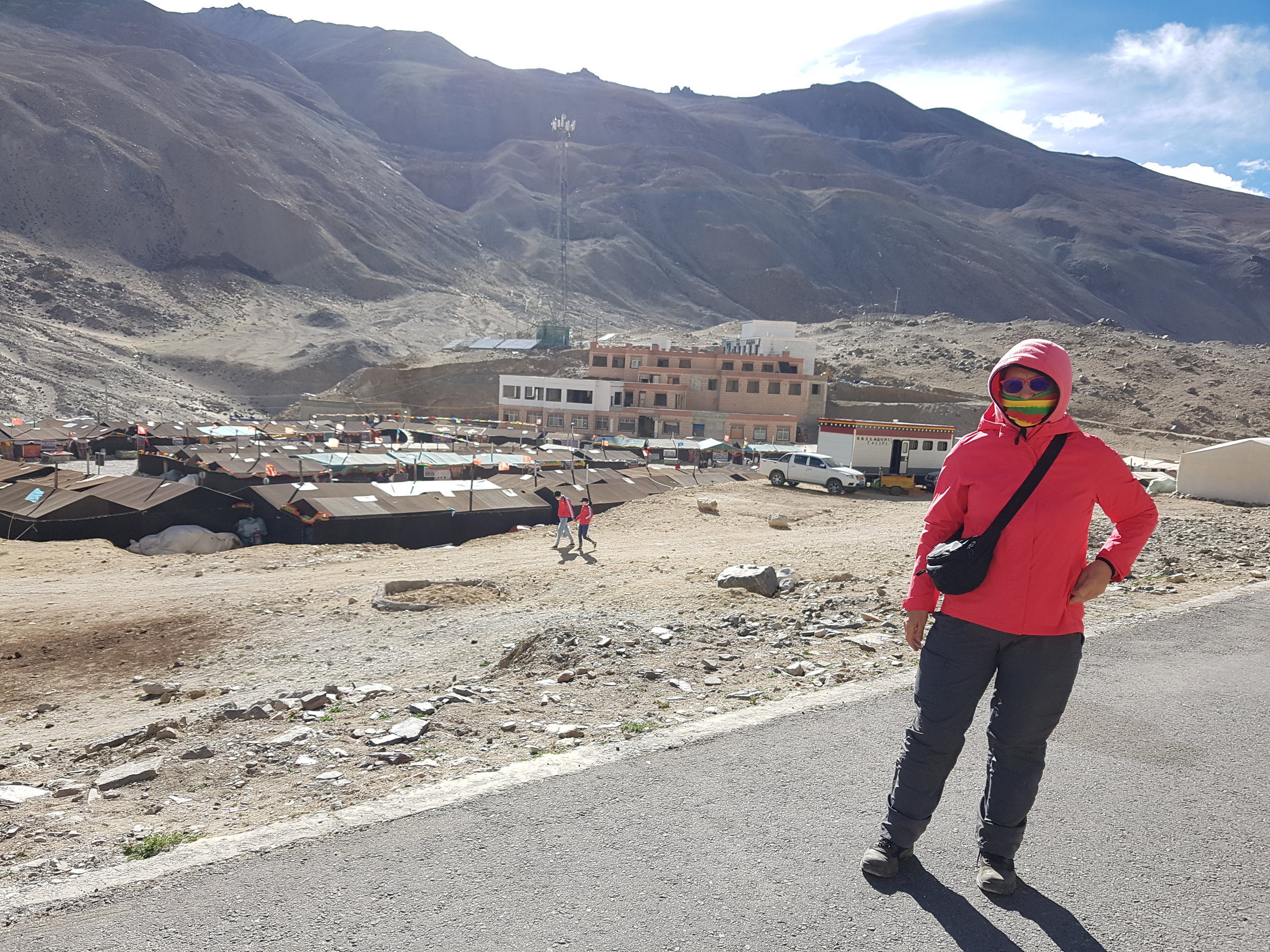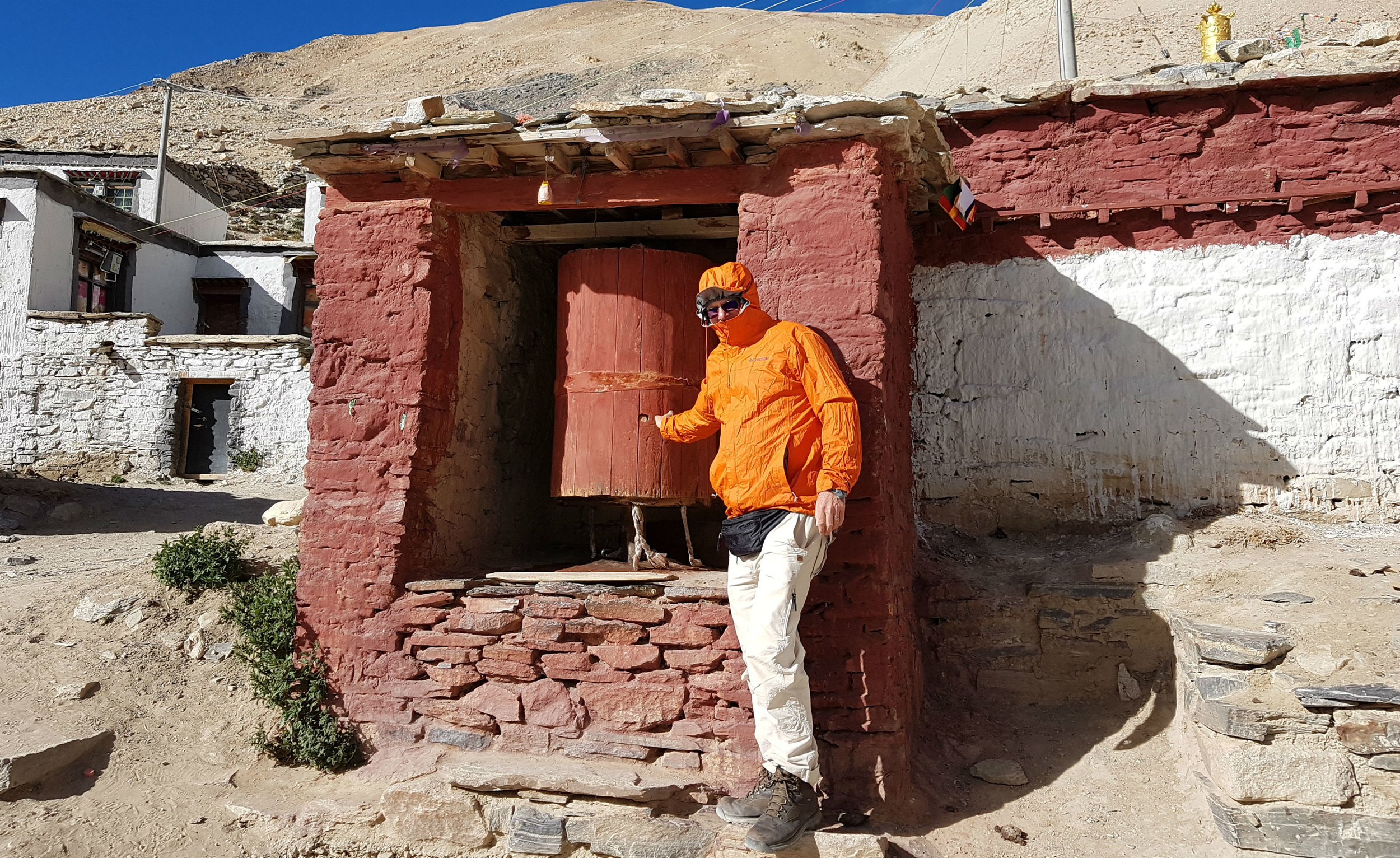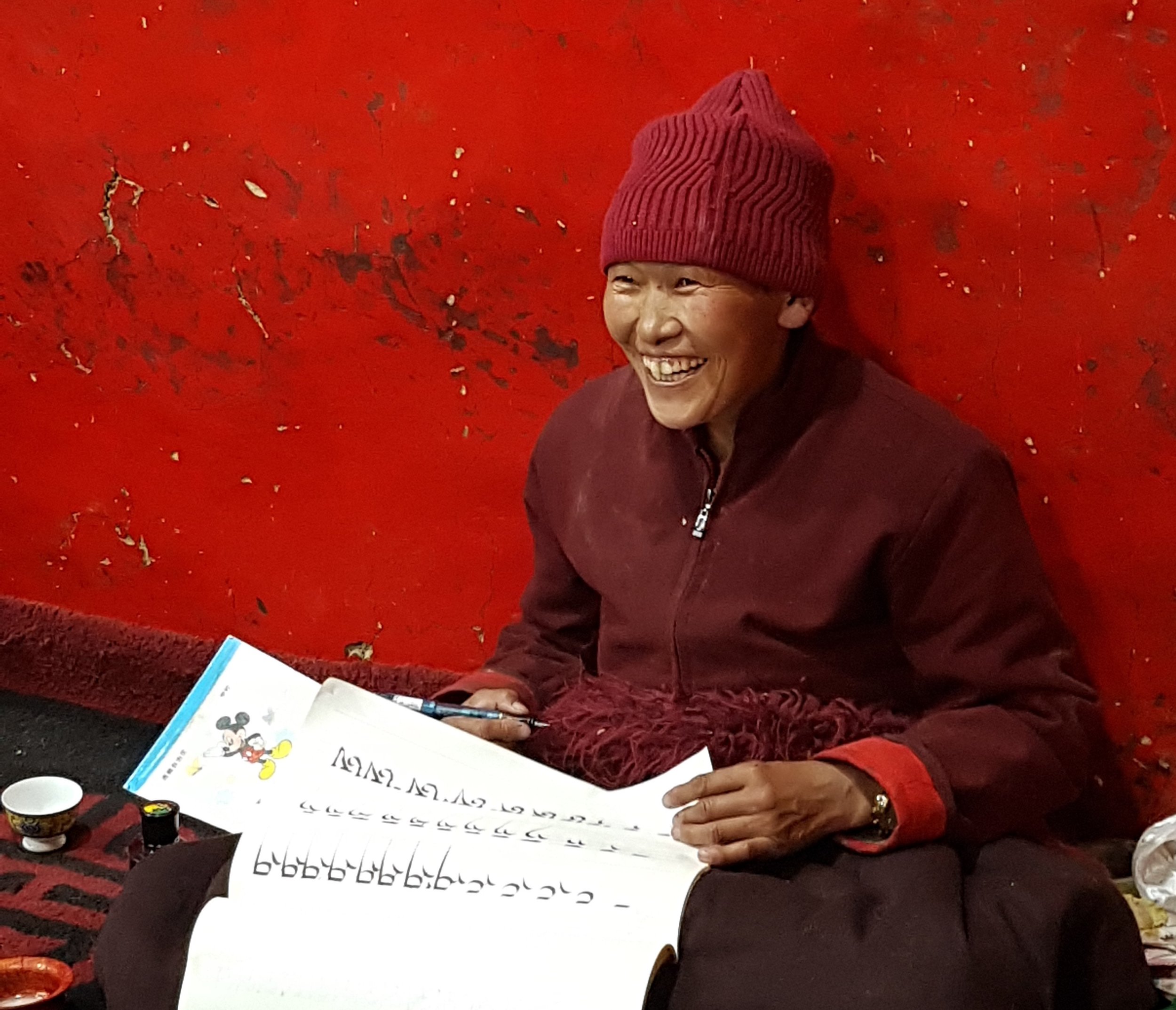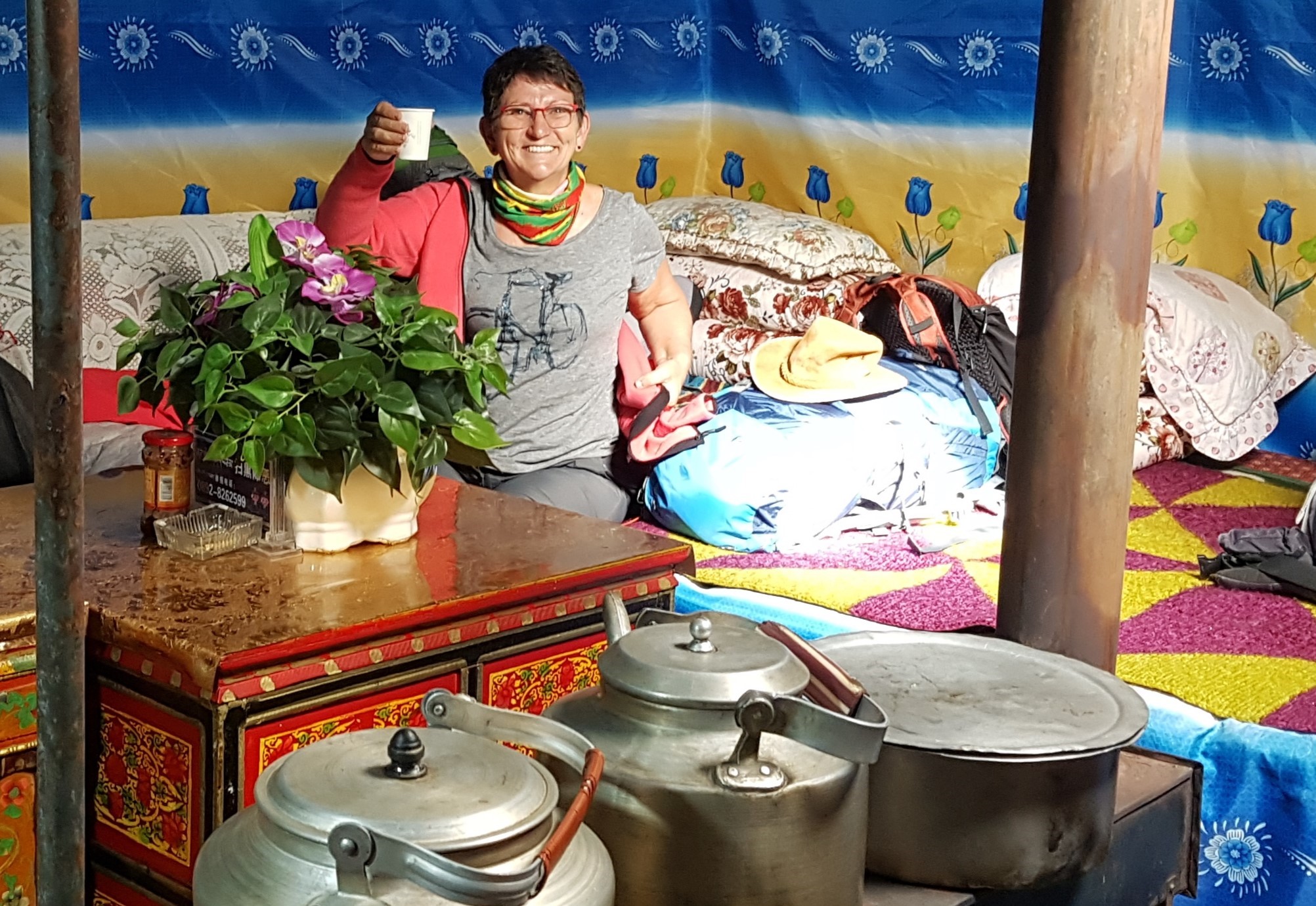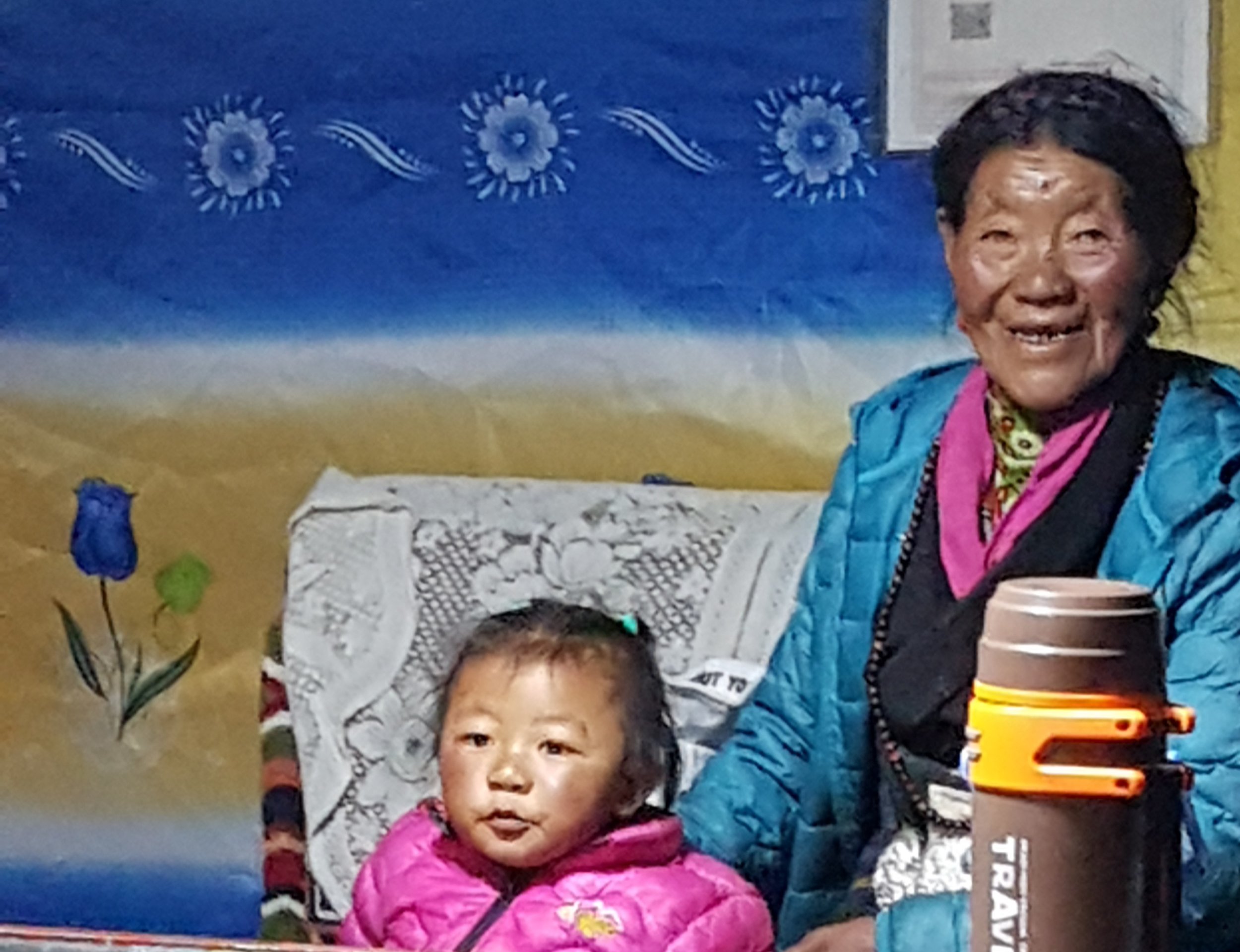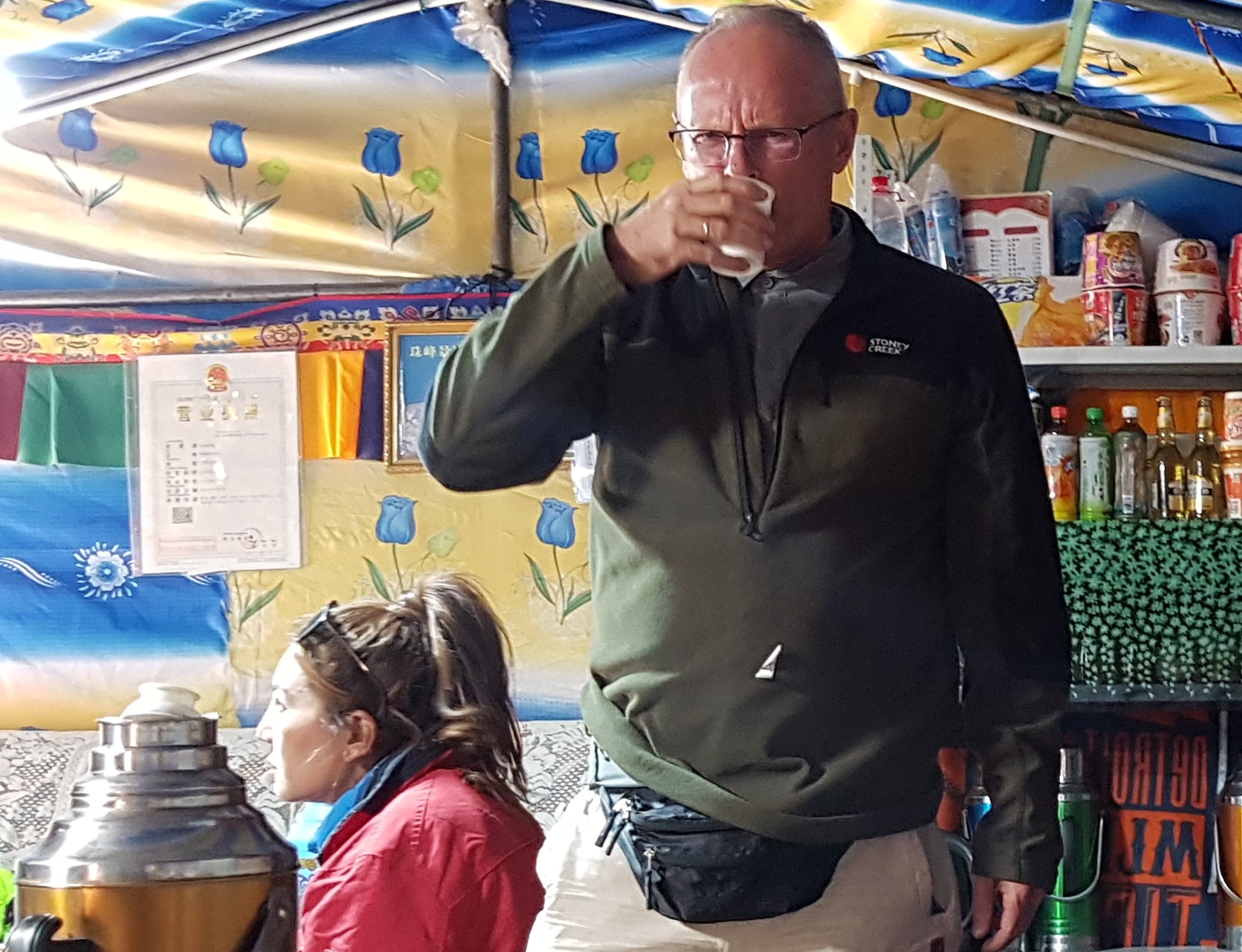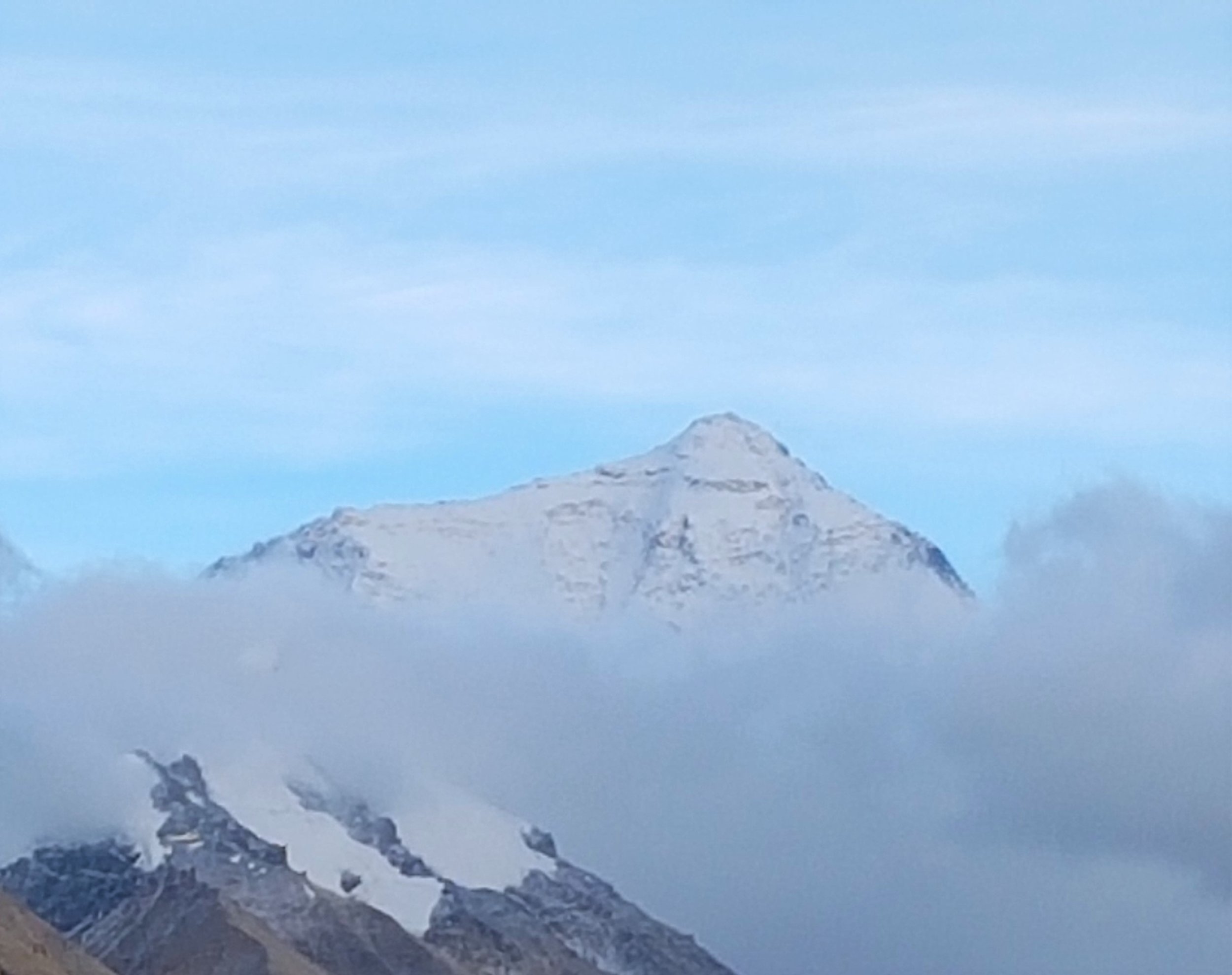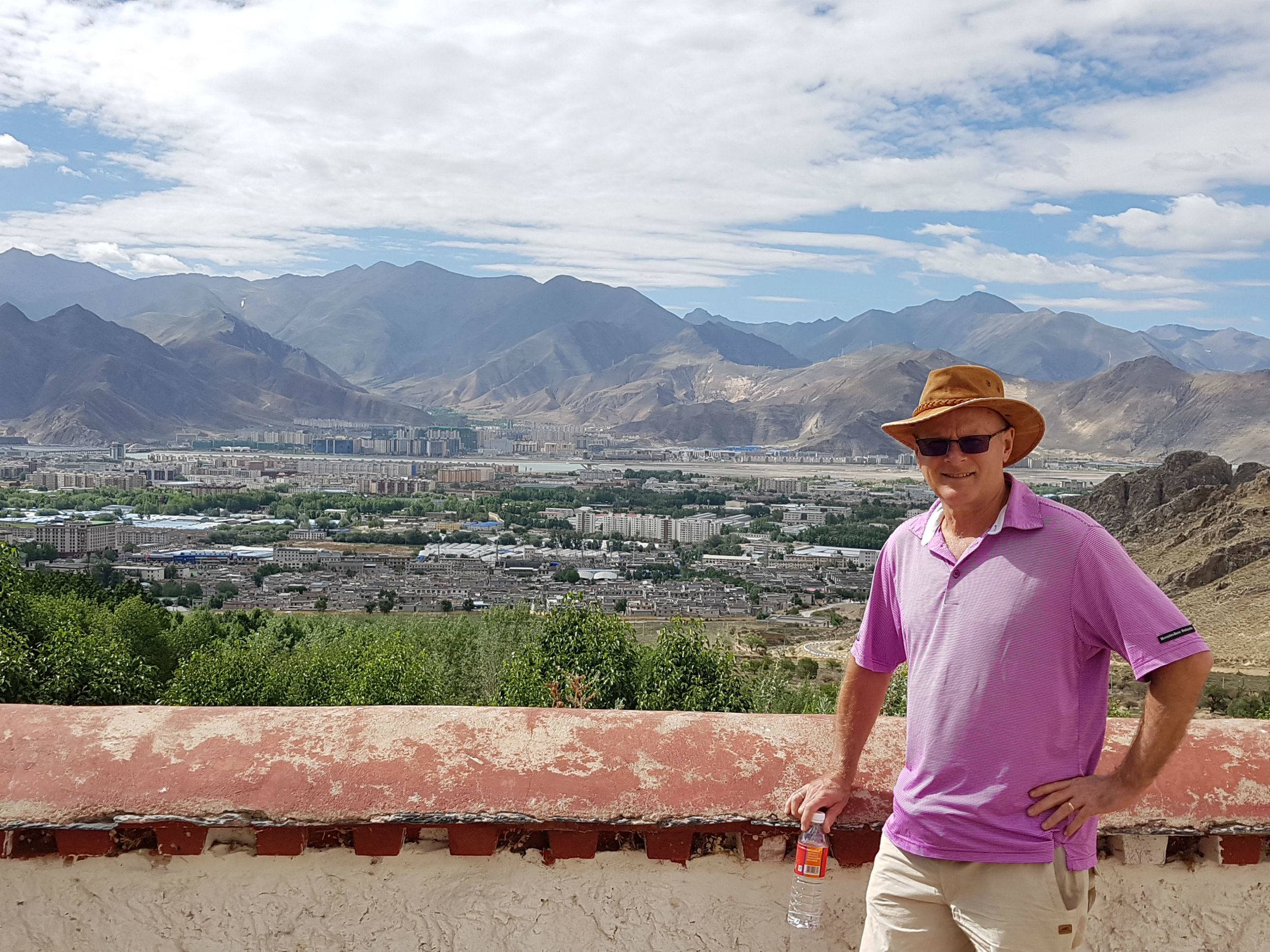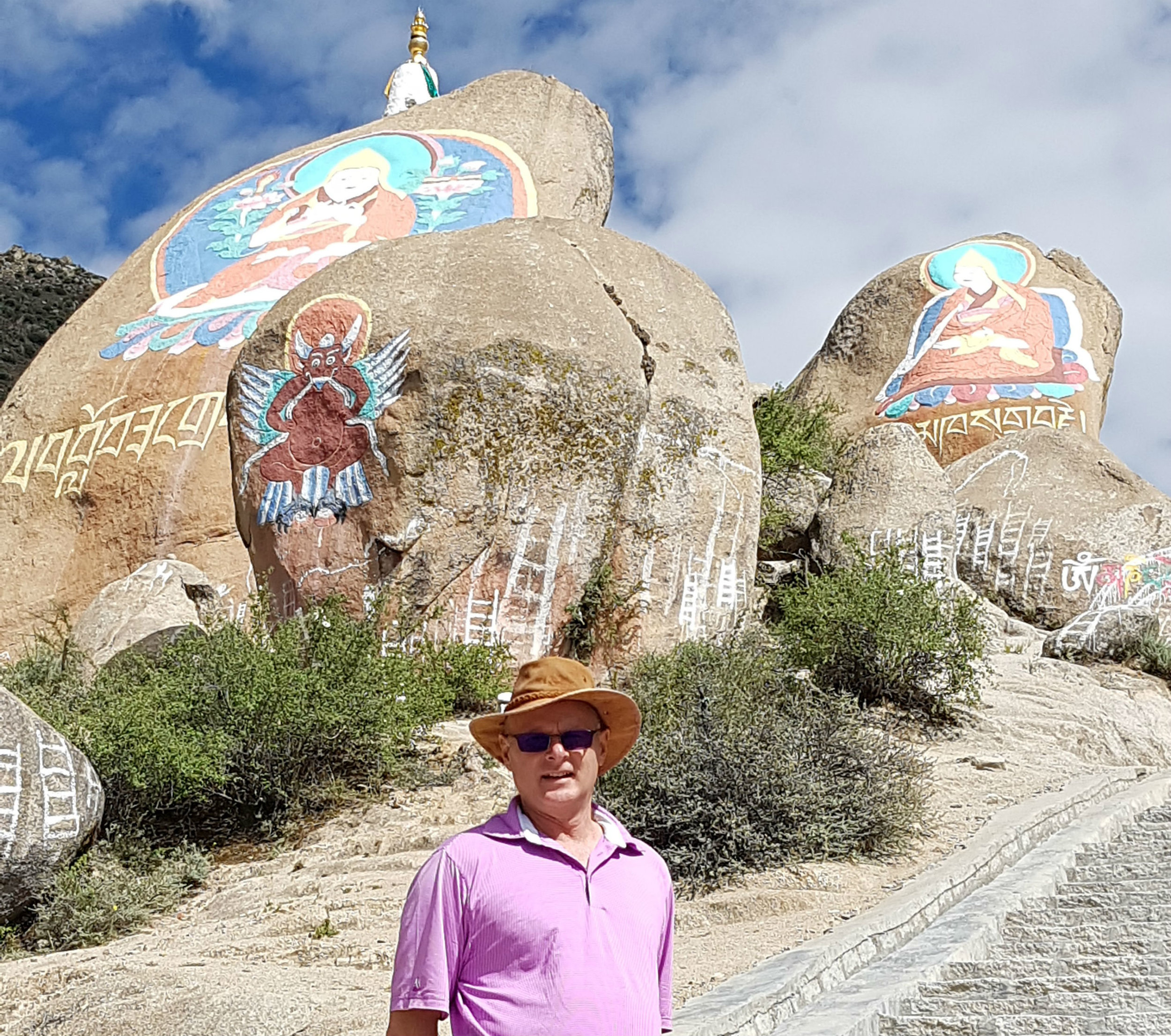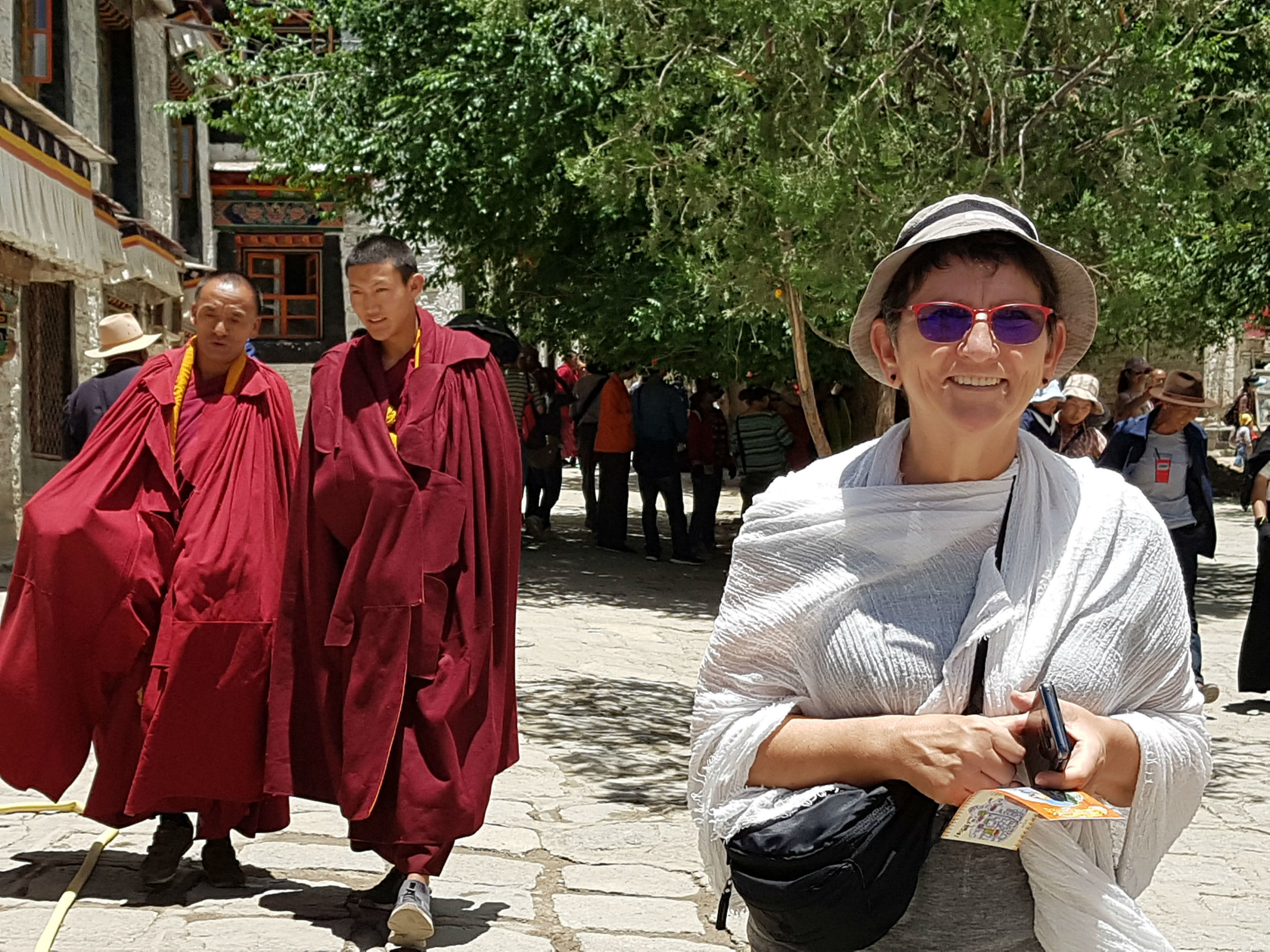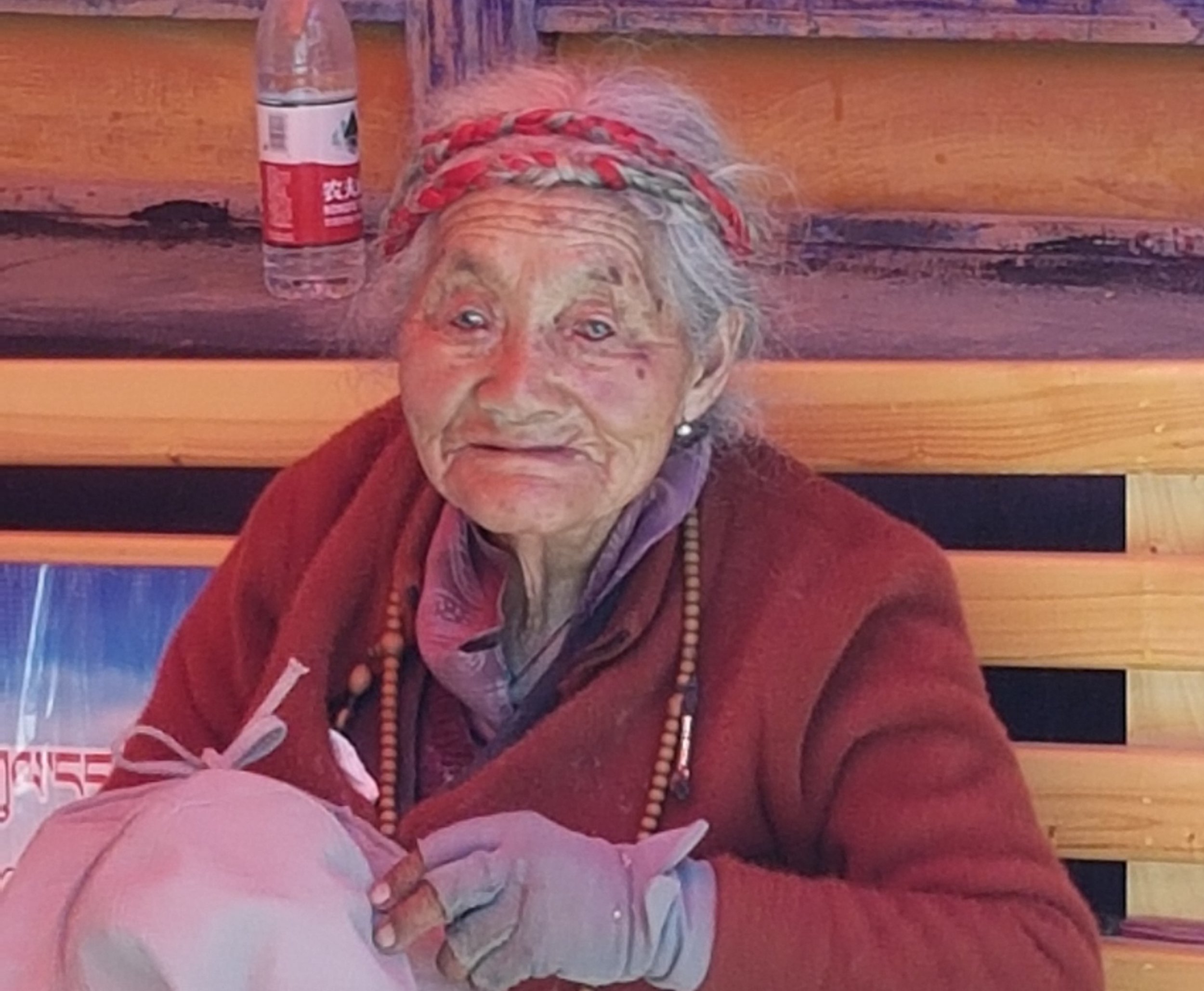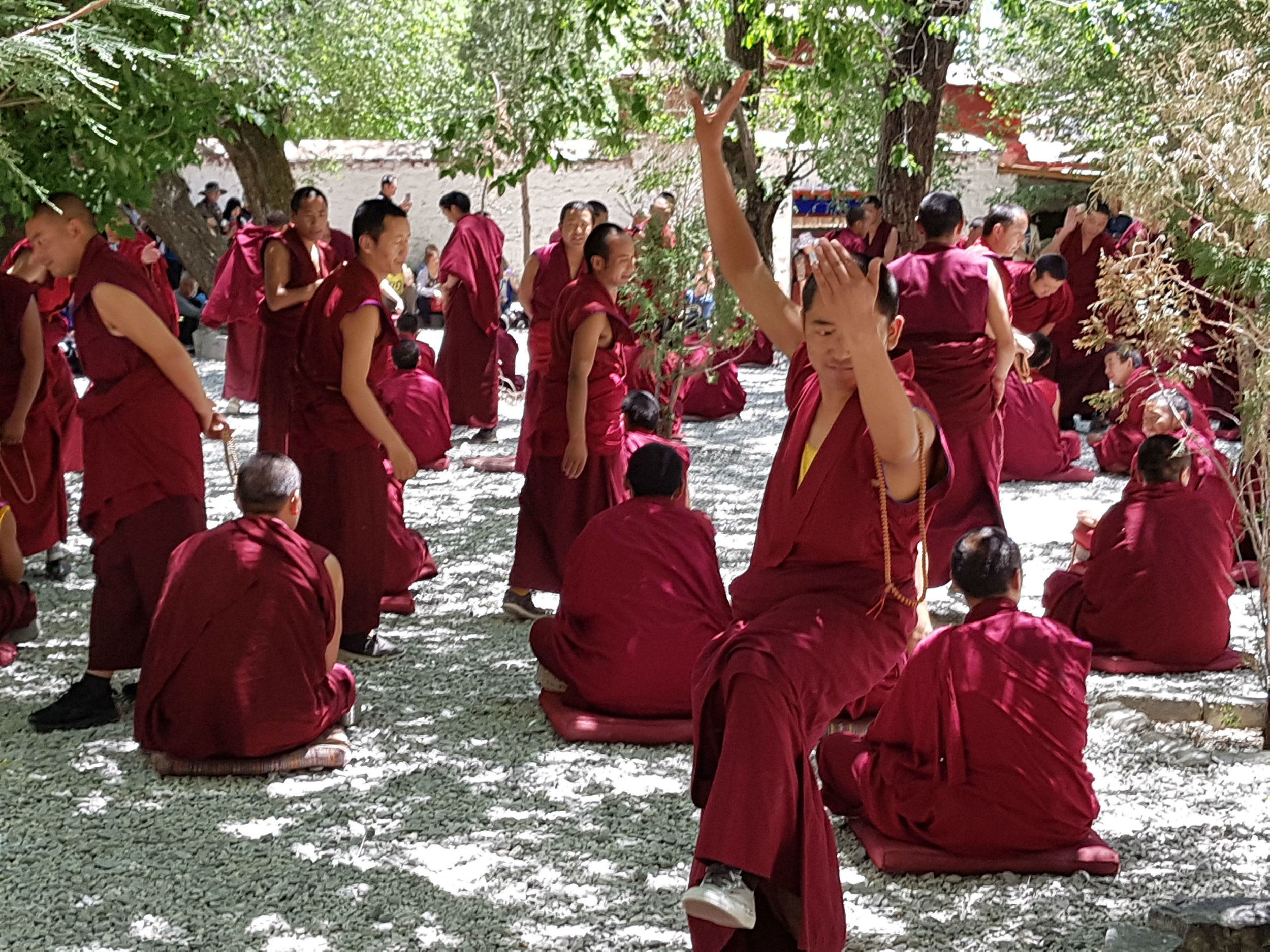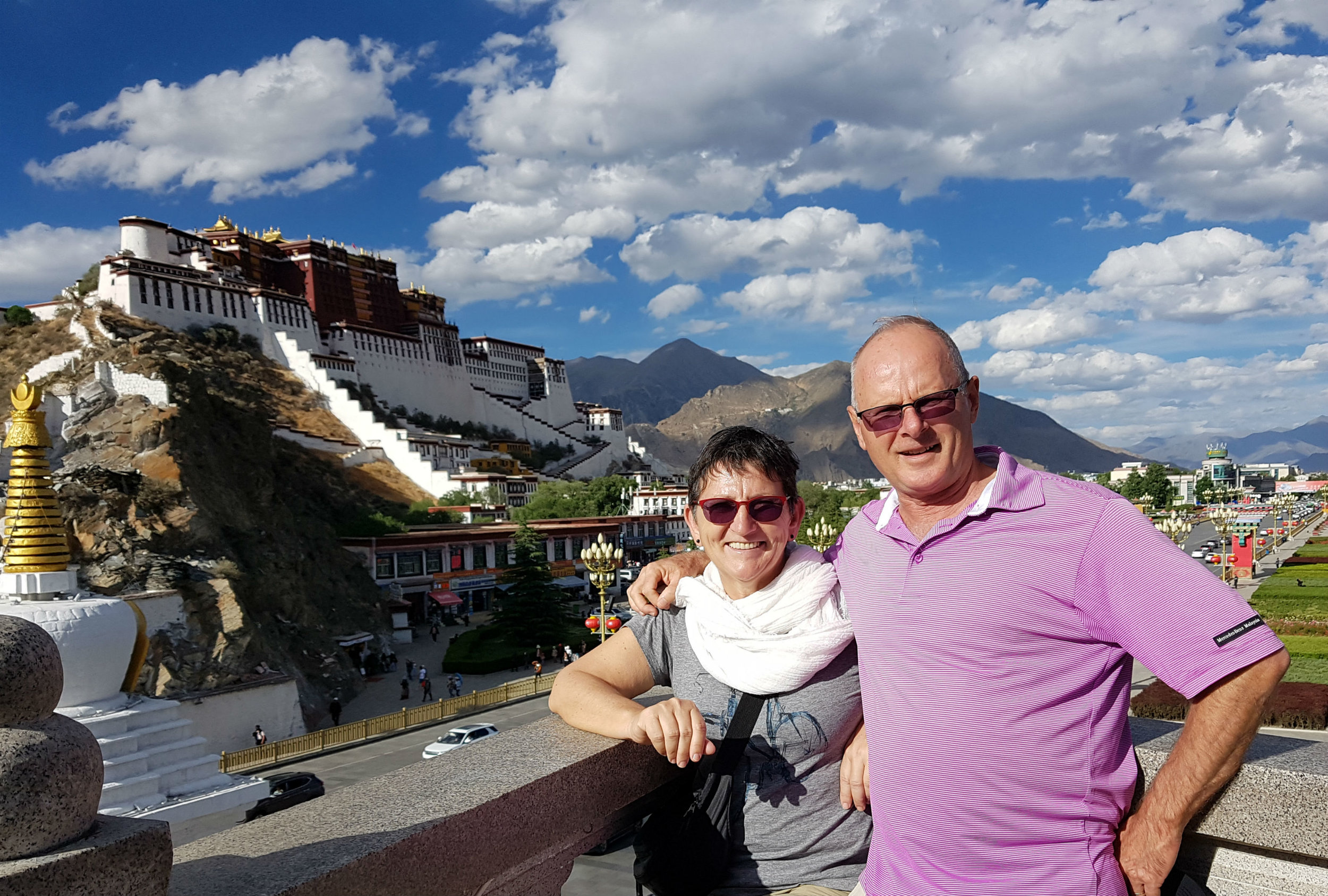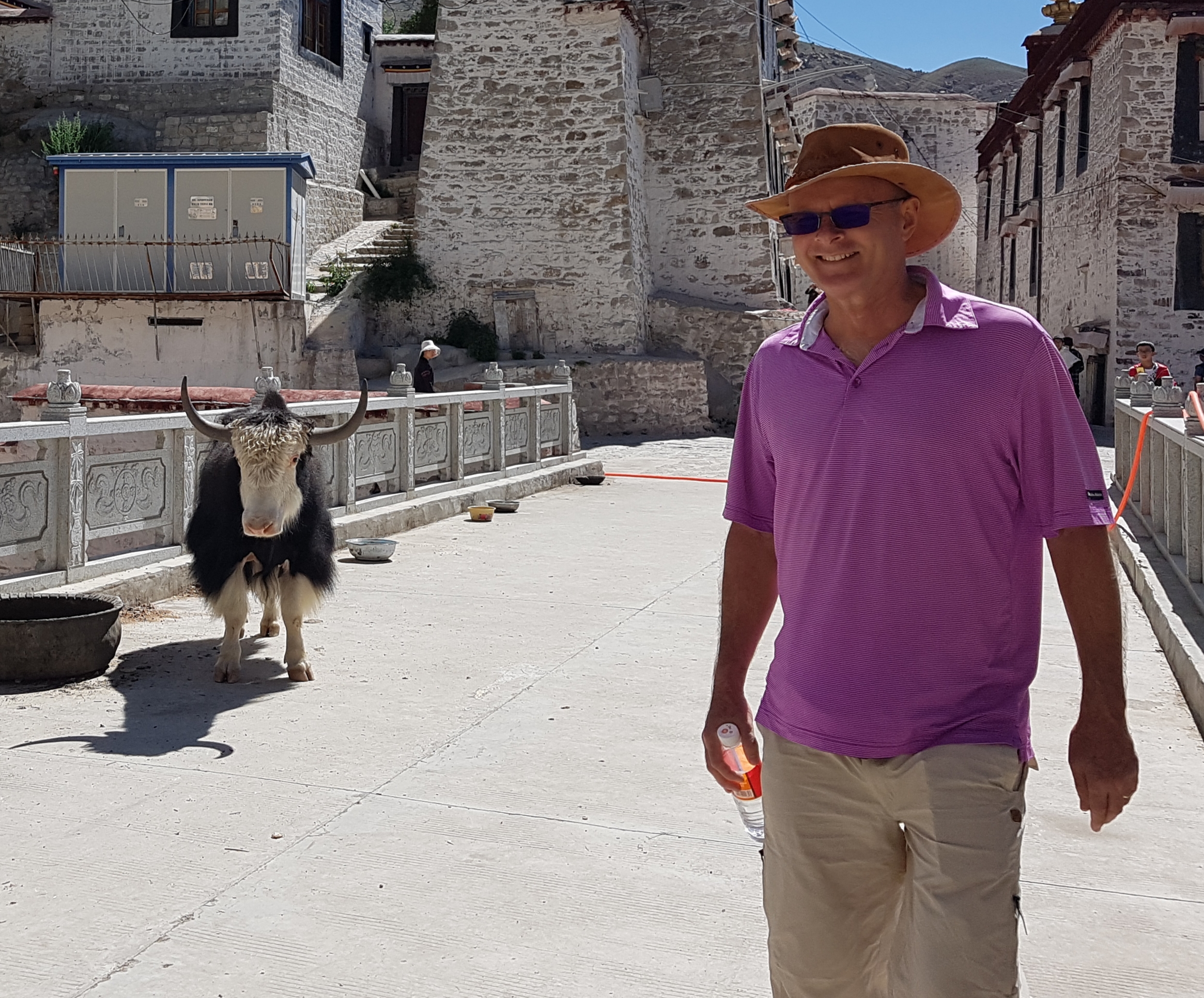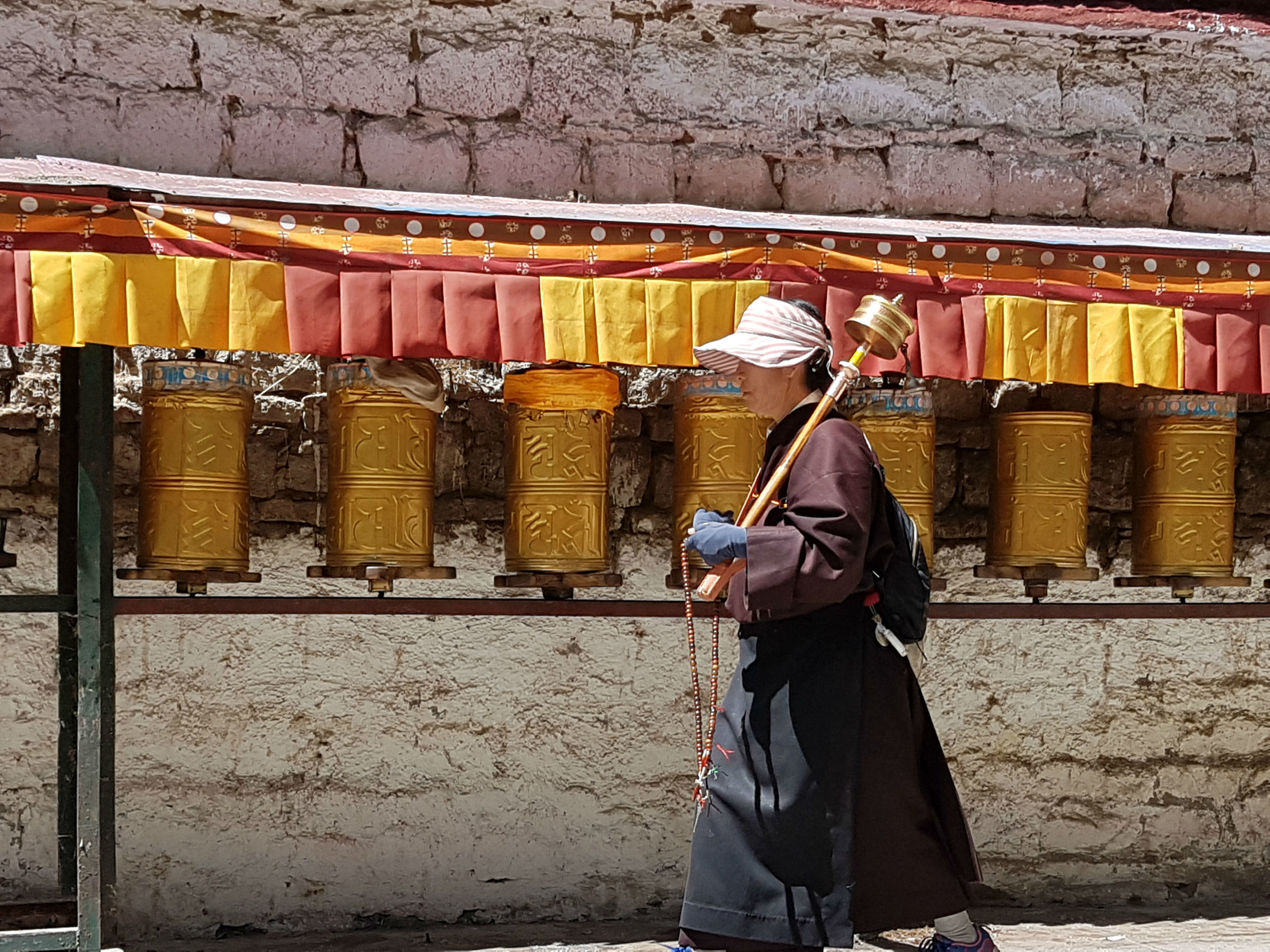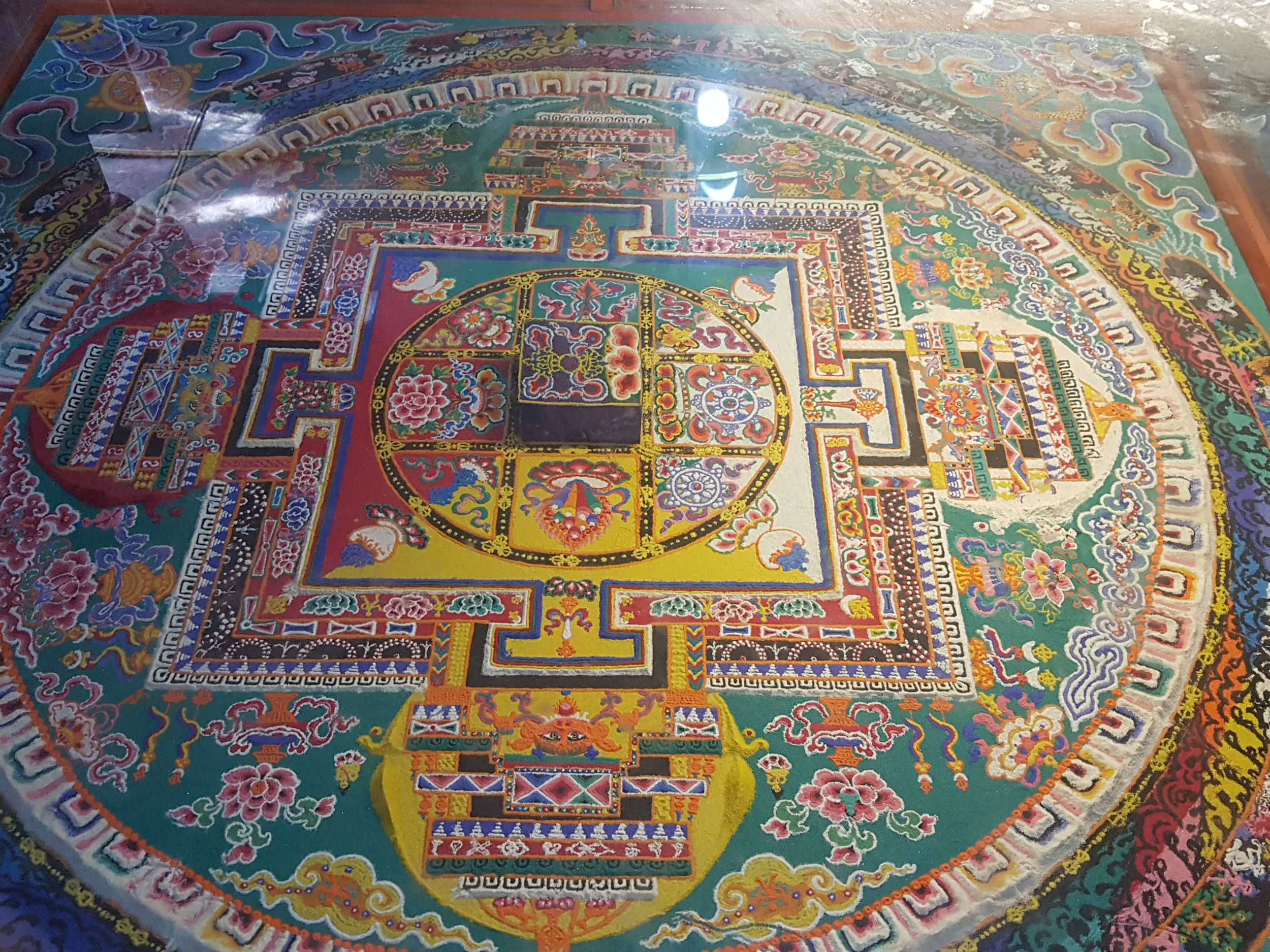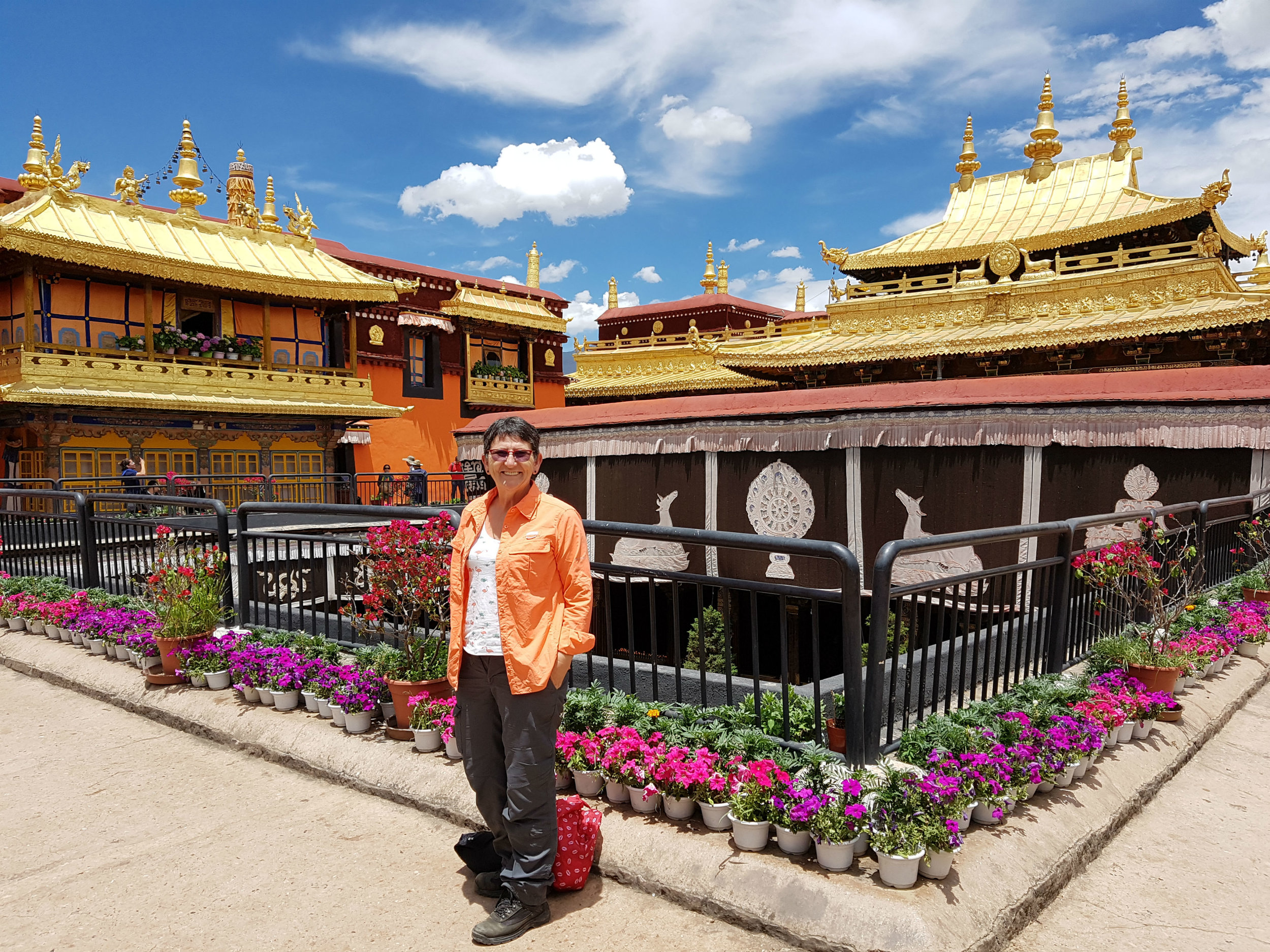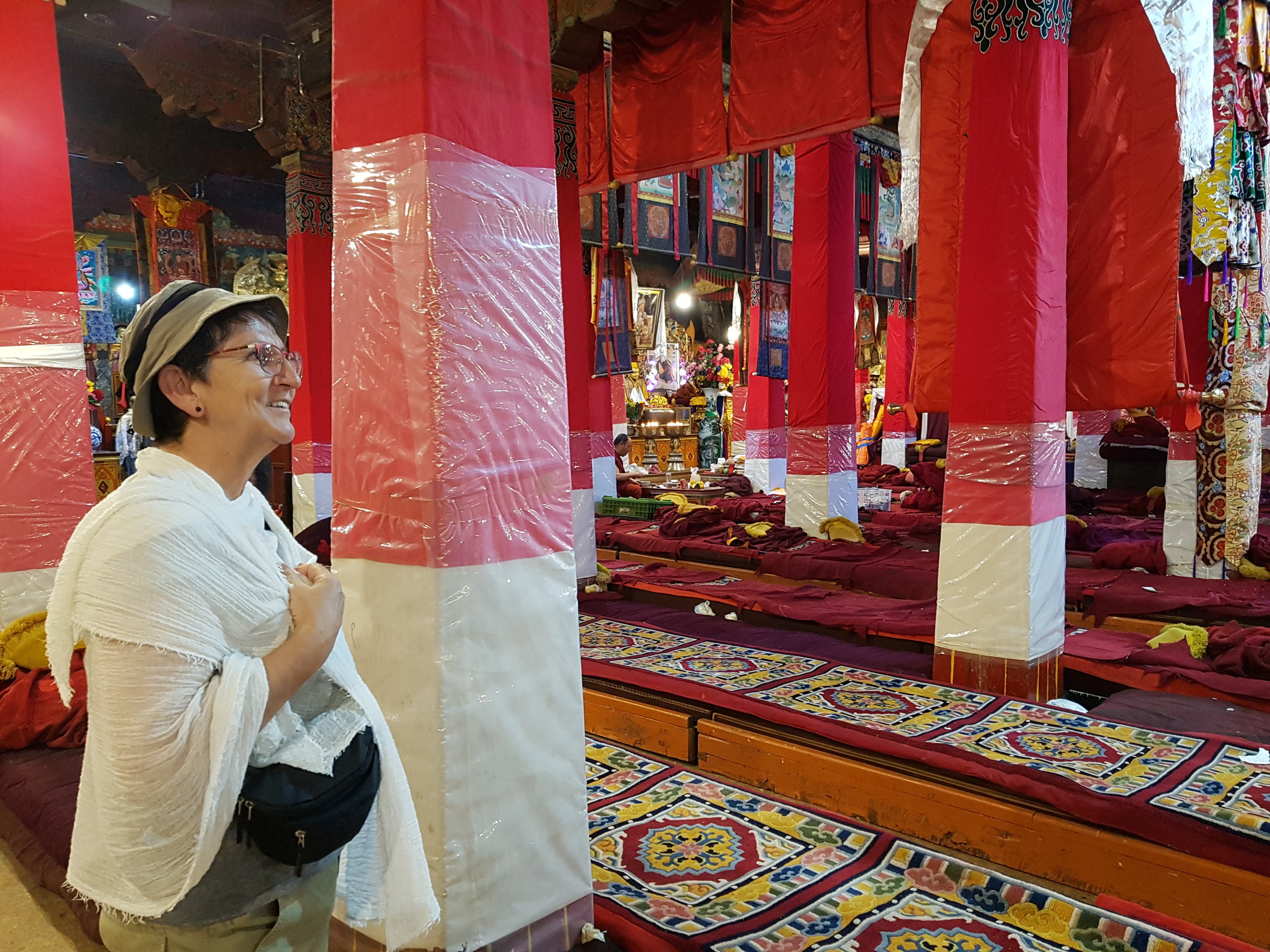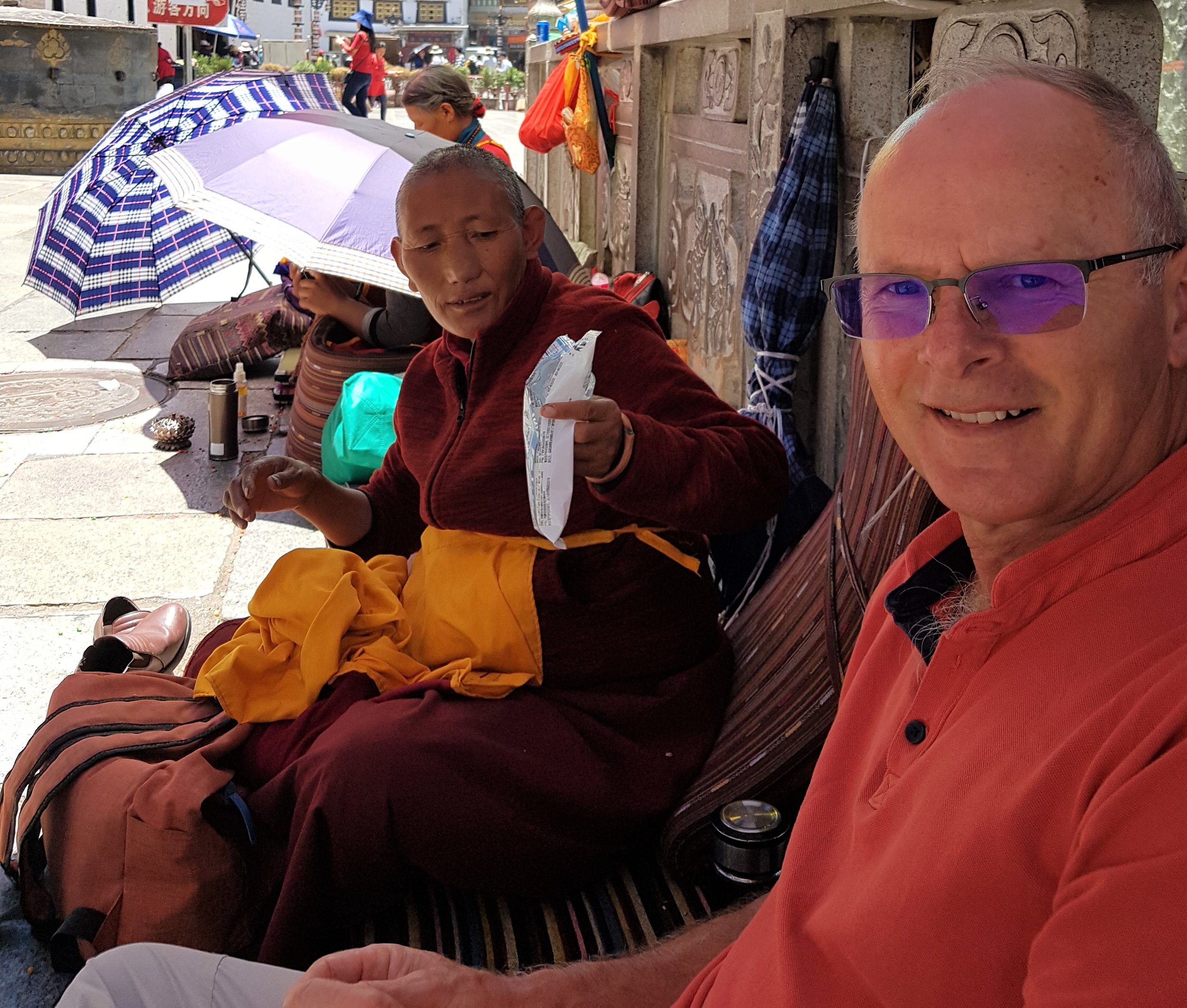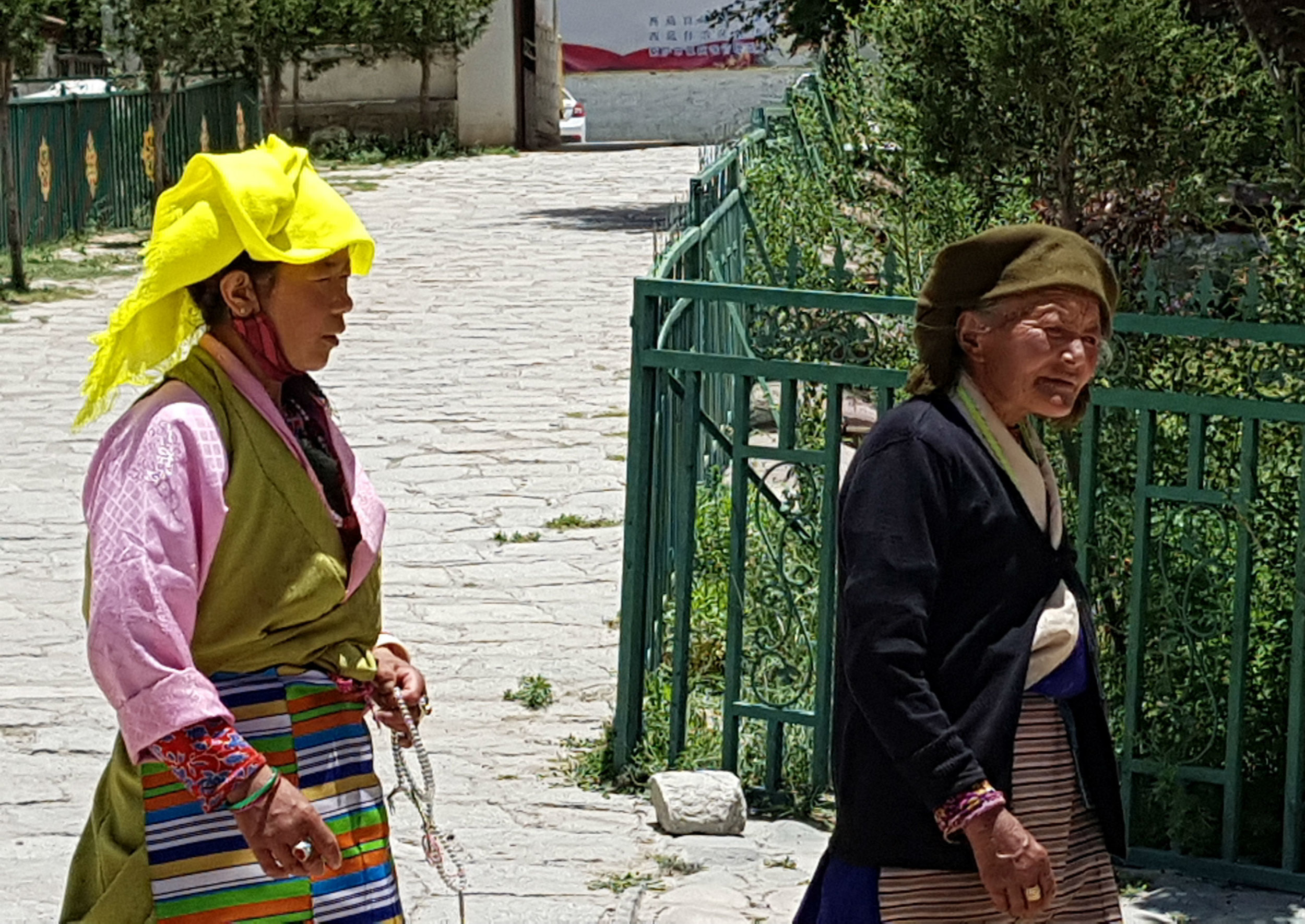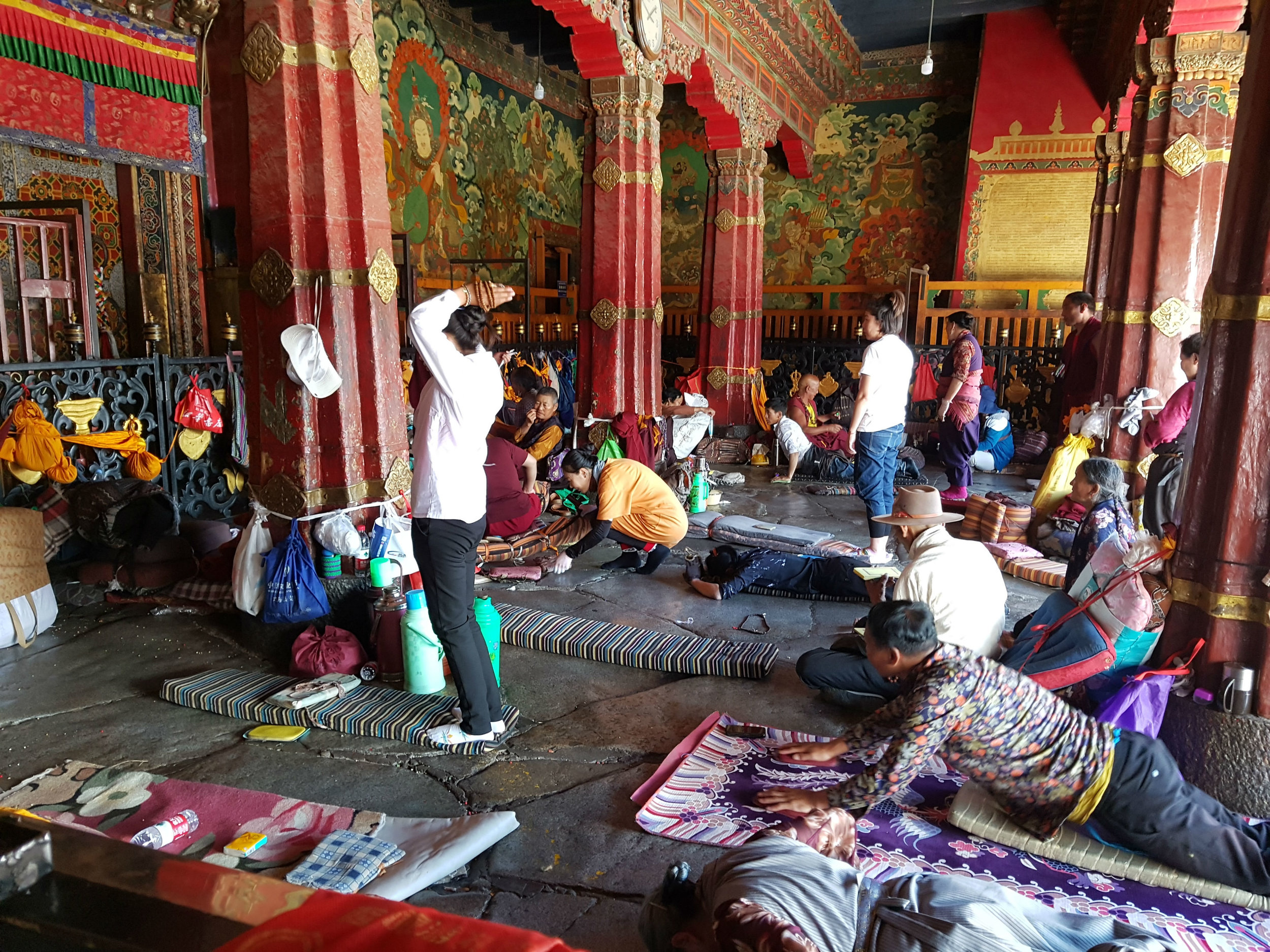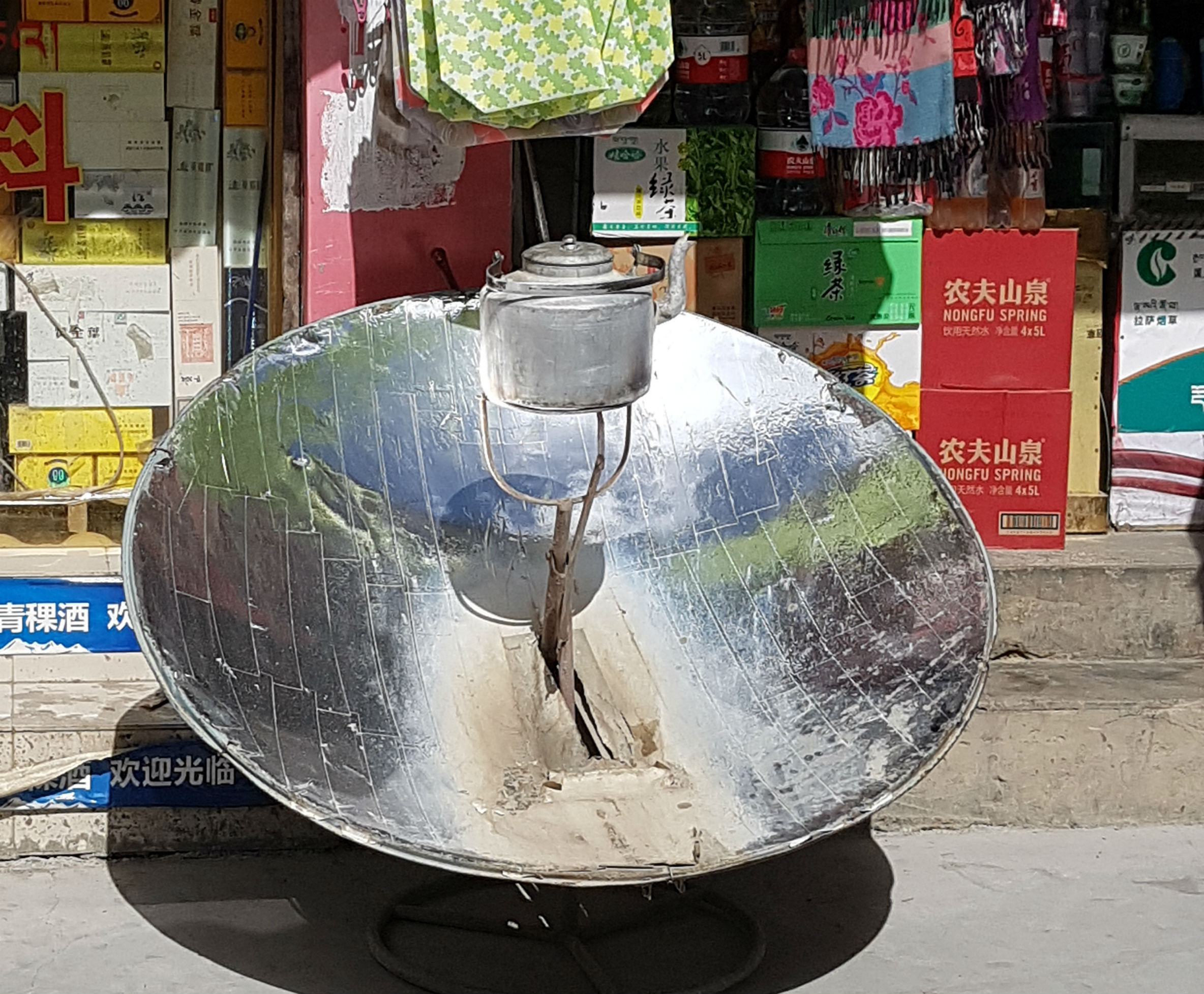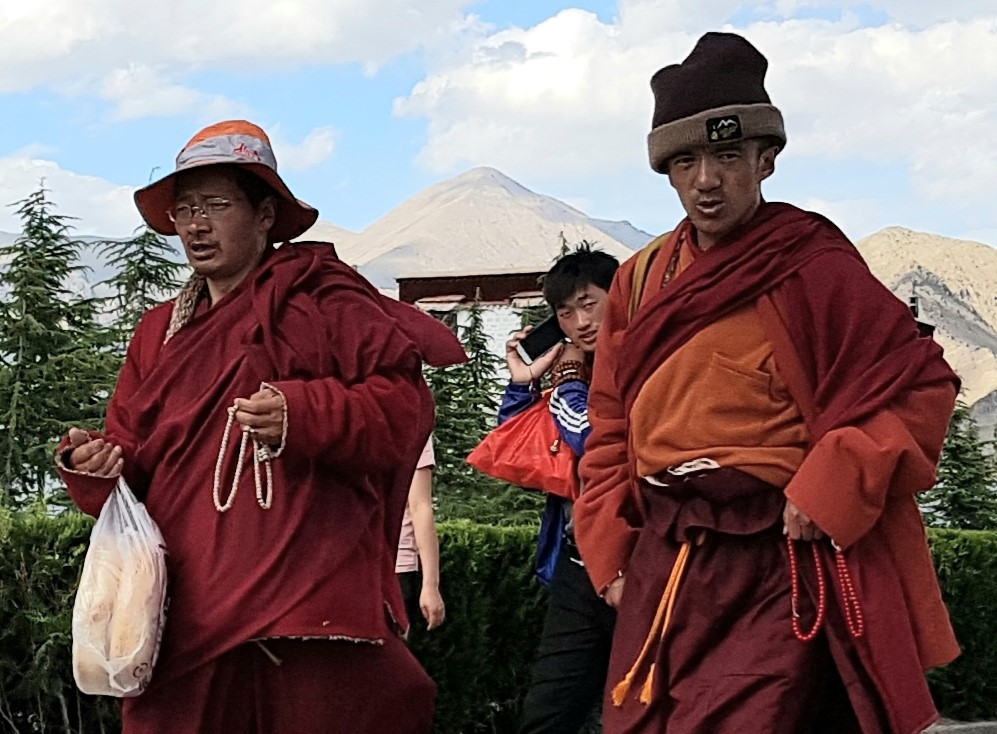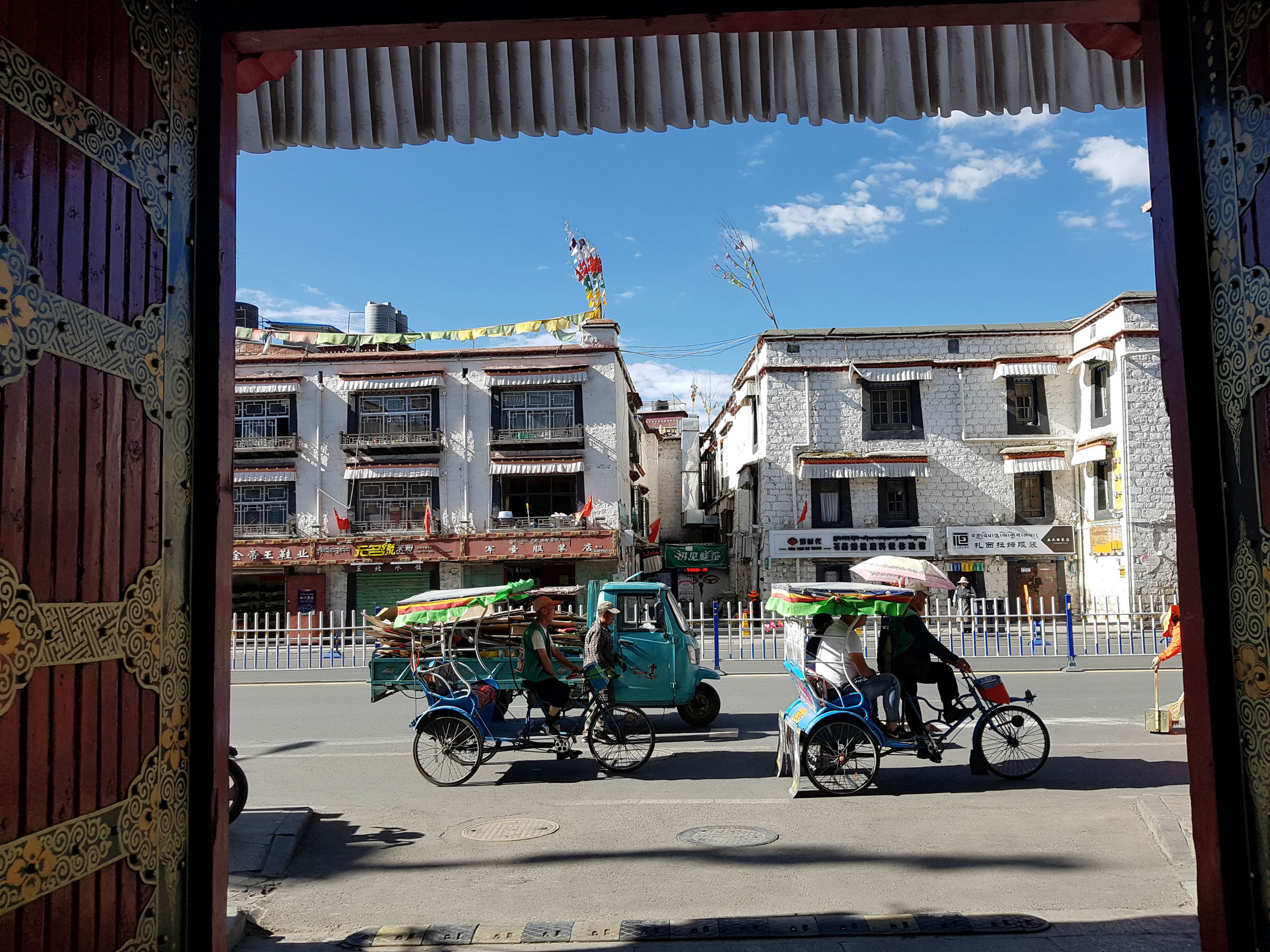With few expectations and an open mind-set, Francien and I started our trip to Tibet in Xining, the capital of Qinghai province in central China. We boarded the train after our passports and Tibet travel permits were thoroughly validated by the staff at the station. This 2000 kilometers train journey to Lhasa took us from a 2200 meters elevation to 3650 meters, crossing several high mountain passes. The train-line for the most part is above an altitude of 4000 meters. 700 kilometers of the track is built on permafrost. It is the highest train journey in the world. Well above the treeline, we saw no natural grown trees and we did not realize that the next two weeks indeed we would not see any trees anymore. We crossed silent bare plains with no fences or gates, occasional covered with snow. We saw dozens of yak, a few Tibetan Mastiff dogs, deer, sheep, horses and goats. After passing over the 5070 meters snow dusted Tang La Pass, the train stopped a few minutes at An Duo, at 4702 meters the highest railway station in the world. It felt surreal. Closer to Lhasa we passed sand dunes, but then the landscape became a bit greener, covered with sturdy shrubs with more yaks and horses roaming the endless loneliness.
At higher elevations the concentration of oxygen in the air inside the train was raised from the normal 21% to about 25% to help the passengers cope with the symptoms of altitude sickness. It worked for us, because that night we slept comfortably in our four-bunk compartment, shared with a silent Chinese couple. By morning, our plastic water bottle had been pressurized to the point where it looked ready to explode. We were the only Westerners on board: all were tourist groups from Hong Kong, China or Taiwan, some making a pilgrimage to Buddhist monasteries in Lhasa. The people were friendly, we managed to communicate with them using our English-Chinese smart-phone translator app.
Having arrived in Lhasa, the first days we struggled to climb the stairs to the third floor of our hotel. We quickly learned that breathing was difficult, but doable as long as we moved (very - very) slowly. The high elevation not only changed the color of our lips, but also my taste bugs: a favorite Snicker chocolate bar tasted horrible! The air was bone dry, sometimes dust swirled in the air, clogging up our noses with fine sand. We had to wear a big hat and sunglasses at all times, because the UV-radiation was intense. The bright blue sky reminded me of the one’s we had enjoyed in Johannesburg, South Africa in the winter.
We stayed three days in Lhasa to acclimatize before we continued our journey in a minibus to the Everest Base Camp. We crossed mountain passes, cut through narrow gorges, passed steep rock faces, followed rivers, passed the Korola glacier and deep blue Yamdrok lake, amid rugged towering mountains.
While our driver was taking a rest, I stood on top of the 5250 meters high Gyatsola Pass and I took in the steep hairpin-bended road we just had climbed, dreading the idea we had to descend on the other side on an even more dizzying road.
‘I can smell the brakes of our minibus’, I said to him. ‘Should we not drive down the mountains a bit slower?’.
‘No problem, Tibetan brakes are good brakes!’, he tried to reassure me, but I didn’t believe him.
Driving the final hours to the Everest Base Camp was a winding paved road up craggy bare mountains with occasional plains. We saw snow covered seven-thousanders close by.
After two days driving, we finally reached the camp. 49 Tents made of black yak hair provided shelter for the tourists. There was a guesthouse, two toilet containers, a few souvenir stalls and a new four-story hotel was being build. Local children were playing with a ball between the tents. Monks lived in stone houses next to the Rongbuk monastery. Except for a hand-full of western looking tourist, all visitors were Chinese.
Dry and dusty, we were in the rain shadow of the Himalaya. Air humidity was a mere 20%, UV-intensity extreme high according to the local weather station. In the evening the wind let down and when I peeled back the hoot of my jacket, I saw Mount Everest peeking through the high sun-lit clouds. I was amazed, grabbed my smartphone and made some pictures.
In the camp there was no running water, no sewage, but WIFI and solar powered 4G. Our tent had a stove in middle heated with dry yak dung. A mother with two toddlers lived in our tent and cooked for us noodle and rice dishes. There was always hot water on the stove to make tea. Our host, dressed in sturdy traditional clothing, received the money for the food she prepared for us, using the ‘Wechat’ app on her smartphone. Old meets new!
At night our guide provided us with oxygen bottles, but fortunately we did not need them.
The next morning the temperature had dropped to -1 C. It was cloudy above the Himalaya, but we could see the top of Everest North Face clearly. Considering we were already at 5100 meters; a sight Francien and I will not forget easily!
The road back to Lhasa via Shingatse goes parallel to the Brahmaputra river, winding through gorges, through valleys, past steep rock faces. We saw mountain goats next to road, stopped at roadside eateries for lunch and ate delicious goat milk ice-cream. Perched on the top of a round edged hill I gazed at the surrounding mountains and thought about the land we just had driven through. There is no substitute for traveling to places like Tibet: difficult to describe what it looks and feels like. The dryness reminded me of the desert in Saudi Arabia, the emptiness of Namibia, the shortness of breath of my climb up Mt. Kinabalu in Borneo. The mountains: never seen anything like this before……
Everywhere we saw lines of prayer flag (with mantras written on them) flapping in the wind. We also passed sky burial sites. This is the funeral practice for all Tibetan Buddhists, in which their human corpse is placed on a mountain to be eaten by vultures. White ladders are painted on rocks at the foot of those holy mountains, symbolically showing the way to heaven.
In Lhasa, the Potala Palace is impressive for its size, built in the 7th century, it still dominates the city. The Dai Lamas are buried here in golden tombs. Each tomb contains 900 – 1500 kg of pure gold! We climbed 374 steps up to see the rooms used by these former religious leaders, their scriptures and endless Buddha statues. At the Sera monastery, built in 1419 and perched on a hillside overlooking Lhasa, our guide explained to us the symbolism used in the common kitchen, the prayer hall, the dormitories, the statues, prayer drums, donation boxes and lecture hall amid air thick of incense and smell of candles made of yak ghee. In a courtyard, monks debated ardently with each other as an exercise to train their brains. They use various gestures to enhance the intensity of their debate, which makes for a real spectacle to watch. In the Old Town we joined the crowds at the Jokhang Temple, which was founded 1,400 years ago by King Songtsen Gampo, who brought Buddhism to Tibet. With its golden roofs it is the most holy in Tibet. We joined thousands of devotees performing a clockwise Kora: a pilgrimage circuit around the temple. We walked among waddling old ladies dressed in colorful close-fitting robes with brightly decorated aprons at the waist, youngsters wearing jeans talking into their smart phones, men in fur-lined bell hats spinning their hand-held prayer wheels, others mumbling mantras and rolling big prayer drums. In their midst a few pilgrims were prostrating themselves, sliding onto their stomachs, progressing body length by body length. It was dusty and the high-altitude sunlight was brutal. Apart from all the beautiful Buddhist artifacts, palaces, monasteries and temples, this was the most impressive to me seeing the total devotion of these people. As I watched all this happening around me, a man approached me. He had red-brown jaws, a masculine round face and burned skin. He wore a double-layered robe and started talking to me in perfect English. He turned out to be a Buddhist teacher for western students and we got into a conversation:
‘Why are so many people here today and even more police and military watching all this?’ I asked him. He carefully looked over his shoulders and whispered:
‘Today is the birthday of our King’. He paused and saw in my face that I did not understood what he meant and continued:
People prostrating themselves in the Jokhang Temple in Lhasa
‘The Dai Lama is our King, but we are not allowed to mention him. In fact, until a few years ago his birthday was a public holiday in Tibet, but this is not allowed anymore’.
Monks debating in the Sera Monastery
‘We like foreigners and you should come here more often.’ he greeted me with a broad smile and disappeared in the crowds.
This explained the heavily armed police (carrying shields, rifles and helmets) and indeed soldiers in armored vehicles patrolling the narrow streets and visibly standing watch on the flat roof tops. Approximately every 50 meters police in riot gear stood guard rather provocative between the pilgrims. Everywhere we have been there were many security cameras, road check points checking for our Tibet travel permits and for the locals document scanners, which I found already excessive. But these security measures felt intimidating.
This was not the only time a friendly local approached us. A day earlier Francien and I strolled in front of the Potala Palace when a Tibetan man looked at me, took my arm and shook my hand, wishing us both all the best as far as we can tell as we could not understand what he was saying. And this old lady sitting in front of the Jokhang Temple who gestured that I should come and sit next to her. I did and as soon as I crouched down, looking at the praying beats she was cleaning, she grabbed gently my arm and started pulling my hair on my arm. Her facial expression clearly showed me that she did not like hair growing on man’s arms. When we strolled through the streets of Shingatse, a sturdy build man with large cheekbones approached me and did the same: he grabbed my arm, pulled my hair on my arm and shaking his head in disbelieve he said: ‘no good – no good.’ Tibetans have little body hair growth, so they are not used to ‘hairy westerns’.
My blogs are based on random observations and my own biased view of things. During our 1800 kilometers travel in the minibus, we saw the construction of new railway lines, highways, roads, bridges, hotels and guest houses even reaching the Everest Base Camp! All built by the Chinese. What struck me the most was the construction of apartment blocks, office blocks, malls, hospitals, industrial sites, sport facilities and entertainment outlets in and around Lhasa.
I asked our guide: ‘Who will be living in these apartment blocks when completed?’
‘All built by the Chinese for Chinese businesses’, he explained. Those newly constructed apartment blocks in the outskirts were for the locals who live now in the old Lhasa city center. When completed in two years from now, they will be forced to move, because the government will convert the Old Town to cater for mass tourism.
My concern is, that improved infrastructure in and around the Old Town like hotels, trinket shops, food places and entertainment will draw more tourists, but it will come at a price: the area becomes more gentrified by commercial tourism and becomes less a place of culture and history than a place of (cheap-) mass consumption. We have seen this happening in many places around the world.
But to be fair, not all will be bad. These investments will increase the standard of living for the locals, providing better paid jobs, medical care and education.
Our last day in Tibet, Francien and I sat on a roof top terrace enjoying a local Lhasa beer. I looked out at the dry mountains that ring the city on all sides. It dawned on me that not so long ago the Potala Palace and the Old Town were essentially all there was to Lhasa. Now it is fast-changing.
This country ticks every box to be an interesting place for the adventurous type of people: the high altitude, the dryness, driving on treacherous mountain passes, the language barrier, the food, the religious devotion of the people, the omnipresent security forces. It is an exotic country to visit. At least for now.
Francien and I said goodbye to the Roof of The World, our plane taking off from one of the highest airports in the world, on our way to Beijing…..

